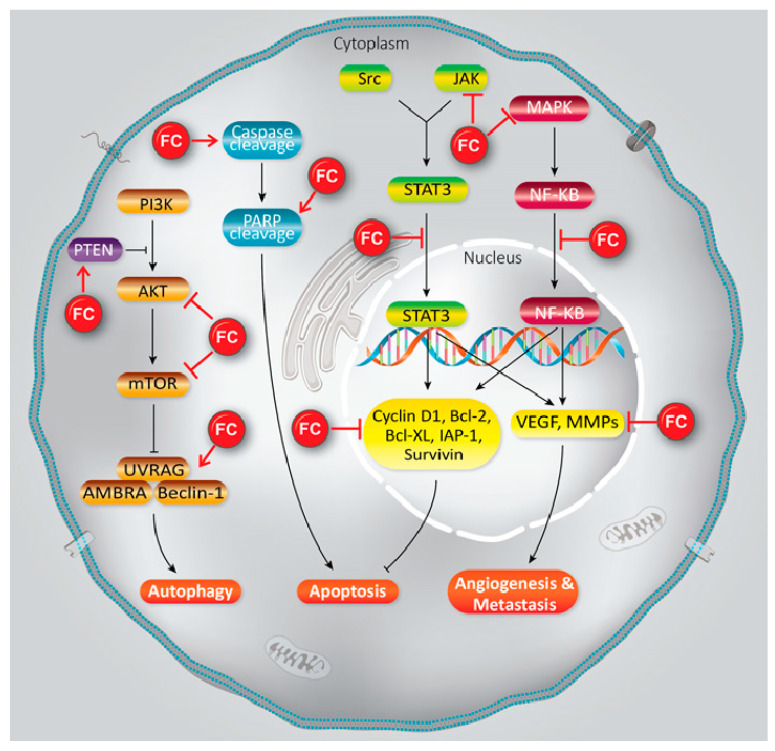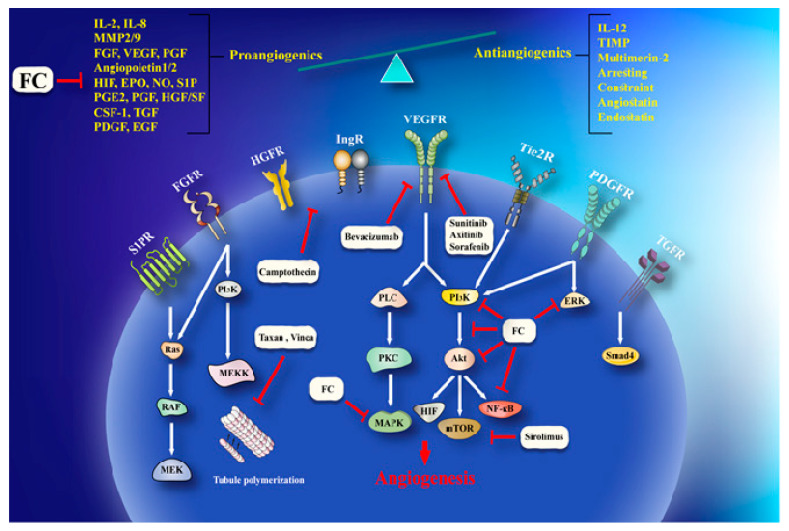Abstract
Cancer is one of the most extreme medical conditions in both developing and developed countries around the world, causing millions of deaths each year. Chemotherapy and/or radiotherapy are key for treatment approaches, but both have numerous adverse health effects. Furthermore, the resistance of cancerous cells to anticancer medication leads to treatment failure. The rising burden of cancer overall requires novel efficacious treatment modalities. Natural medications offer feasible alternative options against malignancy in contrast to western medication. Furanocoumarins’ defensive and restorative impacts have been observed in leukemia, glioma, breast, lung, renal, liver, colon, cervical, ovarian, and prostate malignancies. Experimental findings have shown that furanocoumarins activate multiple signaling pathways, leading to apoptosis, autophagy, antioxidant, antimetastatic, and cell cycle arrest in malignant cells. Additionally, furanocoumarins have been shown to have chemo preventive and chemotherapeutic synergistic potential when used in combination with other anticancer drugs. Here, we address different pathways which are activated by furanocoumarins and their therapeutic efficacy in various tumors. Ideally, this review will trigger interest in furanocoumarins and their potential efficacy and safety as a cancer lessening agents.
Keywords: furanocoumarin, apoptosis, autophagy, metastasis, cell cycle arrest
1. Introduction
Cancer exacts one of the greatest medical tolls on humankind, requiring a proactive procedure for prevention and treatment. An enormous number of patients succumb to cancer every year. It is one of the chief reasons for mortality around the world, and the number of cases is continually expanding and estimated to reach 21 million by 2030. The lack of efficient anticancer treatments remains a clinical problem [1,2]. Chemotherapy and/or radiotherapy are the main clinical approaches to cancer treatment, yet both have documented adverse effects [3,4,5,6]. Cancer treatment affects not only rapidly multiplying cancerous cells but also normal body cells (bone marrow, gastrointestinal tract (GIT), and hair follicles); therefore, these treatments may give rise to severe adverse symptoms. Moreover, quick disposal and widespread distribution of the medications in cancer-free organs requires high dosing, which may lead to incremental adverse reactions. Resistance towards malignant growth is another restriction.
Restorative plants have been utilized previously. Phytopharmaceuticals primarily target malignant growth, and hence, they are the most appropriate contender for anticancer medications [1,2]. Nowadays, significant efforts have improved the efficacy of natural anticancer drugs with the appearance of encouraging strategies [7,8].
Furanocoumarins are phytochemicals that have been utilized for quite a while. The Atharva-Veda, the Indian hallowed book, portrays the Psoralea corylifolia poultice, and the old Egyptians utilized Ammi majus for leukoderma (vitiligo). In 1838, 5-Methoxypsoralen (5-MOP) was the first furanocoumarin isolated from Citrus bergamia oil by Kalbrunner [9]. Furocoumarins are formed by coumarin and a furan ring combination, resulting in angular or linear isomers depending on the furan ring position. Angelicin and psoralen are basic furocoumarins that act as precursors for angular and linear furocoumarins, respectively. These compounds are, for the most part, biosynthesized by phenylpropanoid and the mevalonic pathways. Furocoumarins are produced in plants of Apiaceae and Rutaceae as well as in Asteraceae, Caryophyllaccae, Fabaceae, Moraceae, and Salvadoraceae for defense against insects, bacterial and fungal predators. They provide antimicrobial and insecticidal activity and behave as natural pesticides [10]. Furocoumarins have promising therapeutic prospects, such as analgesic, anticonvulsive, anticoagulant, hypotensive, antidepressants, antibacterial, antifungal, antiviral, anti-inflammatory, antiallergic [11,12], antioxidants [13], and inhibitors of human carbonic anhydrase isozymes [14], against skin diseases [15,16], hyperproliferative disorders [17,18] and as an anticancer [19]. This review is aimed at evaluating the literature on the anticancer potential of various furanocoumarins through different underlying mechanisms and thereof therapeutic/clinical status.
2. Chemistry of Furocoumarins
The exact molecular mechanism of such an activity relies upon the chemical structure of furanocoumarins, which depends on the furan ring and coumarin backbone combination in an angular or linear structure just as the type, location, and the number of the substituents attached [11]. The CH3 presence at C5 improves the tumor properties of psoralen and 5-MOP, paying little heed to the substituent location. The substitution of the methoxy group with an isopentenyloxy moiety in the C5 position prompted abatement in the pro-apoptotic properties of the compound [20,21,22]. Angelicin is the most straightforward angular furanocoumarin and it displays counter cancer properties. Analogous to linear furocoumarins, angular analogs can be substituted with a methoxy or isopentenyloxy group. Methoxy subordinates of angelicin incorporate isobergapten and sphondin. Isobergapten, for example, 5-methoxyangelicine, is a linear isomer of bergapten with a methoxy group joined to the fifth (C5) carbon atom. Thus, sphondin (6-methoxyangelicin) can be considered as an angular analogue of xanthotoxin. The thing that matters is, be that as it may, that the methoxy group is appended to the C6 position in 6-methoxyangelicin and to the C8 atom in the 8-MOP [11].
Furanocoumarins’ defensive and restorative properties have been observed in leukemia, glioma, breast, lung, renal, liver, colon, cervical, ovarian, and prostate malignancies. Apoptosis, autophagy, antioxidant, cell cycle capture, Nuclear Factor Kappa-light-chain-enhancer of activated B cells (NF-κB) inactivation, Phosphatidylinositol 3-kinase/RAC-α Serine/Threonine-Protein Kinase (PI3K/Akt) inhibition, and p53 modulation incorporate mechanistic insight (Table 1; Figure 1). In this article, we have reviewed the experimental data showed the role of furanocoumarins for cancer prevention and treatment.
Table 1.
Anticancer effects of furanocoumarins in the different reported studies.
| Furanocoumarins | Dietary Sources [2,3,4] | In Vitro | In Vivo | Anticancer Mechanisms | References | ||
|---|---|---|---|---|---|---|---|
| Cell Lines | Cytotoxic Concentration | Experimental Model | Dose | ||||
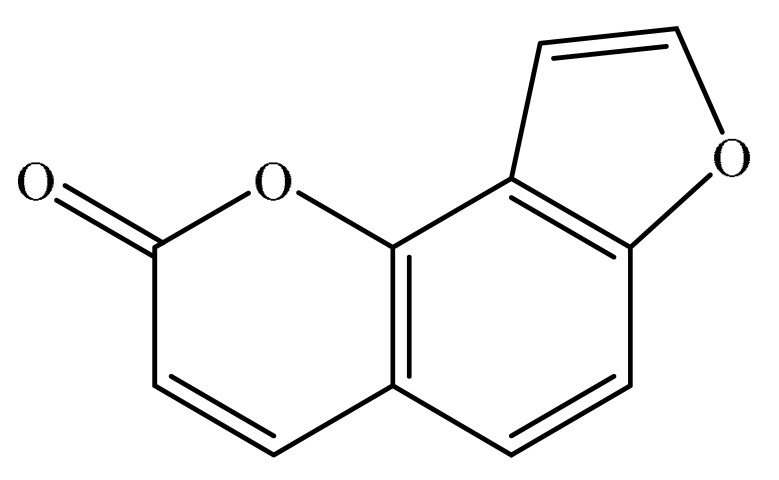 Angelicin |
Parsnip | HeLa and SiHa | IC30 = 27.8 µM; IC50 = 38.2 µM | — | — | Atg3,7 and 12-5 ↑, G1/G0 arrest | [5] |
| A549 (NSCLC) | IC50~ 50 µmol | — | — | NF-κB inactivation G2/M phase arrest, cyclinB1 ↓, cyclin E1 ↓, and Cdc2 ↓; Bcl2 ↓; caspase 3,9 ↑, Bax↑ JNK ↑, ERK ↑; MMP2, MMP9 ↓, E-cadherin ↑ |
[6] | ||
| SH-SY5Y | IC50 = 49.56 μM | — | — | caspase 3,9 ↑, Bcl-2 ↓, Bcl-xL↓, and Mcl-1↓ | [7] | ||
| Caki | IC50 = angelicin (50–100 μM) and TRAIL (50 ng/mL) | — | — | caspase 3↑, c-FLIP ↓ | [8] | ||
| HepG2 and Huh-7 | IC50 = 90 ± 6.565 (HepG2); 60 ± 4.256 μM (Huh-7) | — | — | PI3K/Akt inhibition, Bcl-2↓ | [9] | ||
| — | — | Mouse liver xenograft model (BALB/c-nu/nu mice) | 50 mg/kg (16 days) | cancer cell growth ↓; p-VEGFR ↓ |
[9] | ||
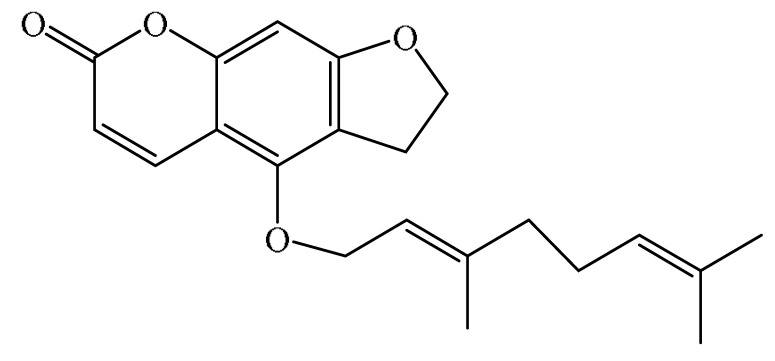 Bergamottin |
Carrot, cumin, dill, fig, grapefruit, lemon, lime, orange, parsley, parsnip | A549, H1299 | IC50 = 50–100 μM | — | — | EMT inhibition, JNK ↑; PI3K ↓, Akt↓, and mTOR kinases ↓ | [10] |
| U87 and U251 | IC50 = 2–10 μM | — | — | NF-κB inactivation, MMP9 ↓, STAT3 inhibition, Rac1 inactivation | [11] | ||
| HT-1080 | IC50 = 5–50 μM | — | — | NF-κB inactivation; MMP2, MMP9↓ | [12] | ||
| HT-29 and RKO | IC50 = 12.5 µM | — | — | caspase-3,8,9↑; PARP ↑; G2/M phase arrest, cyclinA ↓, cyclin B1↓, and Cdc2 ↓ |
[13] | ||
| A549 (NSCLC) | IC50 = 50 μM | — | — | G2/M phase arrest, cyclinA ↓, cyclin B1↓, and Cdc2 ↓ | [14] | ||
| — | — | Mouse lung xenograft model (BALB/c nude mice) | 100 mg/kg (18 days) | ↓ cancer cell growth | [14] | ||
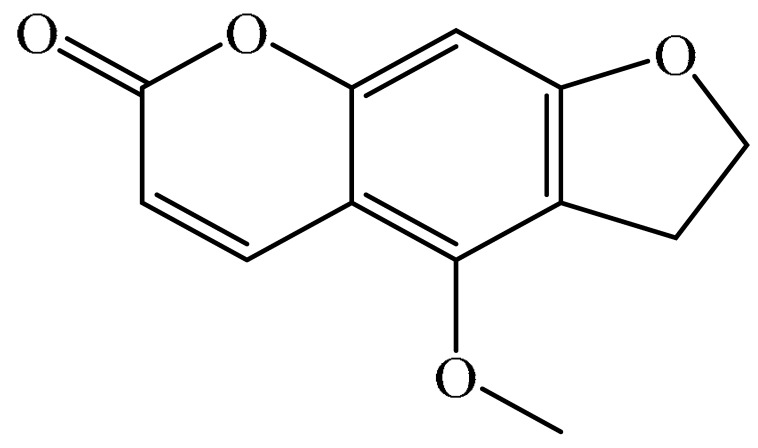 Bergapten or 5-Methoxypsoralen (5-MOP) |
Anise, carrot, caraway, celeriac, celery, coriander, cumin, dill, fig, grapefruit, lemon, lime, orange, parsley, parsnip, turnip | DLD-1 and LoVo | IC50 = 30 and 50 μM | — | — | G2/M phase arrest, cyclin E ↓, Cdk2 inhibition; AKT inhibition; p53 ↑, p21↑, PTEN↑ | [15] |
| MCF-7 | IC50 = 50 μM | — | — | G1-phase phase arrest, P53 ↑; AKT inhibition | [16] | ||
| Hep-G2 | IC50 = 25–50 mM | — | — | G2/M phase arrest, Cdk1 inhibition | [17] | ||
| IC50 = 25–100 μM | — | — | G2-M phase arrest, P53 ↑ and P21 ↑ | [18] | |||
| A549 (NSCLC) | 79.1 ± 2.8% (50 μM) |
— | — | G1-phase arrest, P53 ↑ | [19] | ||
| NCI-H460 | 74.5 ± 3.1% (50 μM) |
— | — | ||||
| MCF7 and ZR-75 | 50 μM | — | — | PTEN ↑, Beclin1 ↑, PI3KIII ↑, UVRAG ↑, AMBRA, LC3-I to LC3-II | [20] | ||
| HepG2 | 50 mM | — | — | PI3K/AKT inhibition, LXR (α and β)↑ | [21] | ||
| — | — | NDEA induced liver cancer (Wistar rats) |
25 and 50 mg/kg (14 days) | ↓ cancer cell growth | |||
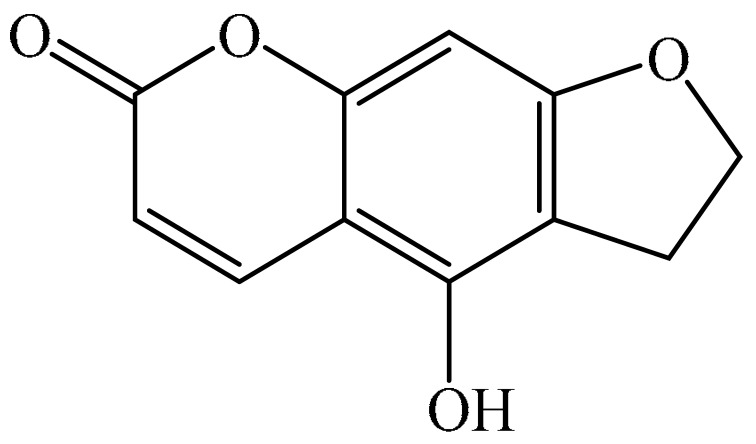 Bergaptol |
Carrot, grapefruit, lemon, lime, parsley, parsnip | MCF-7 | IC50 = 52.2 µM | — | — | G1-phase arrest; caspase 3,9 ↑, Bax↑, Bcl2 ↓,MMP2 ↓, MMP9 ↓, cyt c release ↑ | [22] |
 Byakangelicol |
Lemon | HCT-15 | IC50 = 18.1 ± 0.3 μg·mL−1 | — | — | ↓ cell viability | [23] |
| A549 (NSCLC) | IC50 =14.3 ± 0.2 μg·mL−1 | — | — | ||||
| SK-OV-3 | IC50 = 20.2 ± 0.3 μg·mL−1 | — | — | ||||
| SK-MEL-2 | IC50 = 21.2 ± 0.3 μg·mL−1 | — | — | ||||
| XF498 | IC50 = 28.4 ± 0.3 μg·mL−1 | — | — | ||||
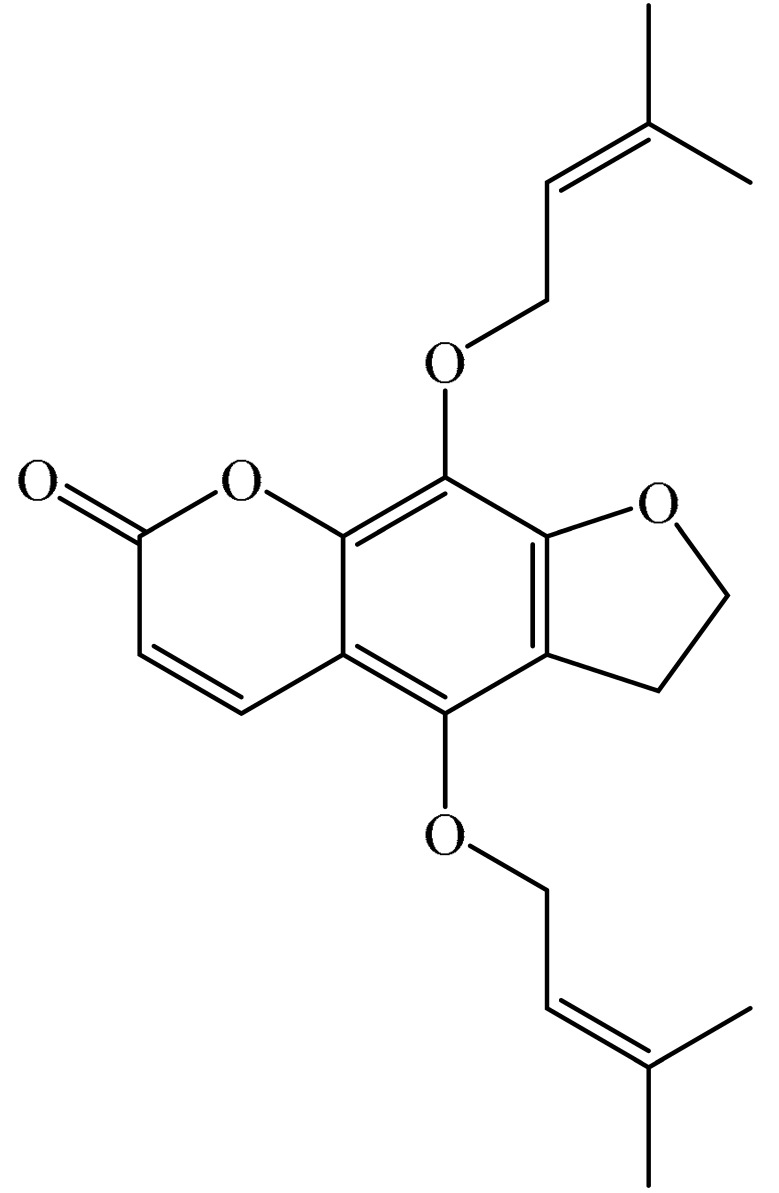 Cnidicin |
Lemon | HCT-15 | IC50 = 7.0 ± 0.2 μg·mL−1 | — | — | ↓ cell viability | [23] |
| A549 (NSCLC) | IC50 = 6.8 ± 0.1 μg·mL−1 | — | — | ||||
| SK-OV-3 | IC50 = 8.8 ± 0.2 μg·mL−1 | — | — | ||||
| SK-MEL-2 | IC50 = 8.8 ± 0.2 μg·mL−1 | — | — | ||||
| XF498 | IC50 = 7.2 ± 0.3 μg·mL−1 | — | — | ||||
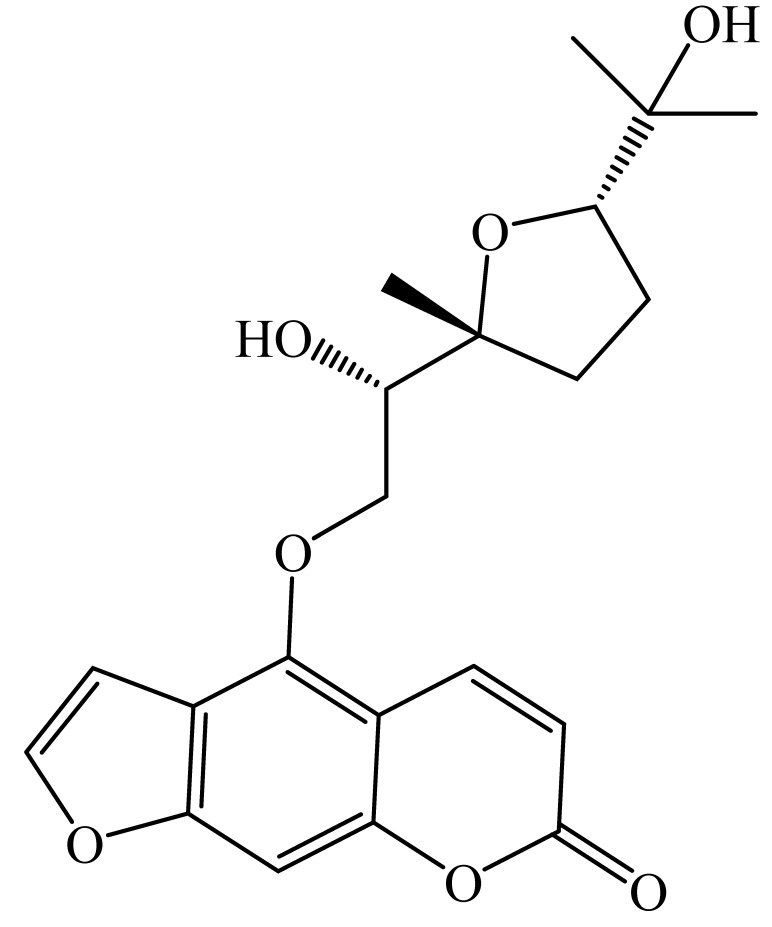 Feroniellin A |
Feroniella lucida roots | A549 | 0.25 mM | — | — | NF-κB inactivation Atg5 ↑, Beclin1 ↑, mTOR inactivation LC3-I to LC3-II |
[24] |
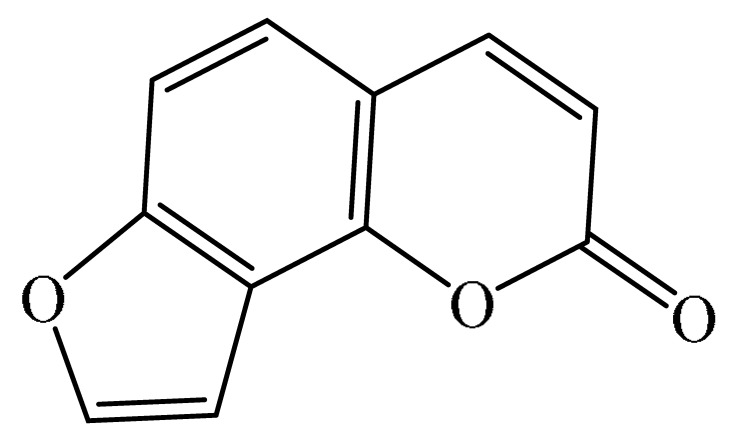 Furanocoumarin A |
Fructus liquidambaris | A549 | IC50 = 65.28 ± 5.36 μM | — | — | P53 ↑,Bax↑, Bcl2 ↓, caspase 3 ↑ | [25] |
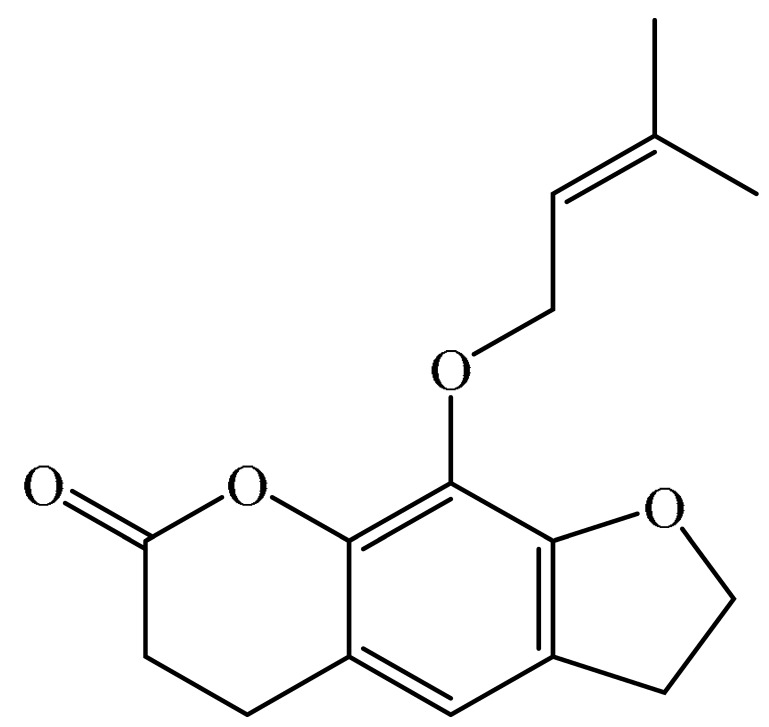 Imperatorin |
Lime, parsley | SGC-7901 | IC50 = 62.6 μM | — | — | promoting G1-phase arrest; PI3K/Akt/m-TOR signaling ↓ | [26] |
| HT-29 | IC50 = 78 µM | — | — | G1-phase arrest; P53 ↑ and P21 ↑; caspase 3,7 ↑; Bcl2 ↓ | [27] | ||
| HL-60 | 10 μM | — | — | caspase 3,9 ↑; cyt c release ↑; Bcl2 ↓, PARP cleavage | [28] | ||
| H23 | 10 μg/mL | — | — | P53 ↑,Bax↑, Mcl-1↓ | [29] | ||
| HeLa | 200 μM for imperatorin and 5 μM for cisplatin | — | — | Hsp27 and Hsp72 ↓,LC3 cleavage | [30] | ||
| HCT116 | 150 μM | mTOR↓, p70S6K ↓, 4E-BP1↓, MAPK↓, HIF-1α inhibition | [31] | ||||
| HCT-15 | IC50 = 19.4 ± 0.3 μg·mL−1 | — | — | ↓ cell viability | [23] | ||
| A549 | IC50 = 16.4 ± 0.3 μg·mL−1 | — | — | ||||
| SK-OV-3 | IC50 =13.7 ± 0.3 μg·mL−1 | — | — | ||||
| SK-MEL-2 | IC50 = 14.5 ± 0.2 μg·mL−1 | — | — | ||||
| XF498 | IC50 = 12.3 ± 0.5 μg·mL−1 | — | — | ||||
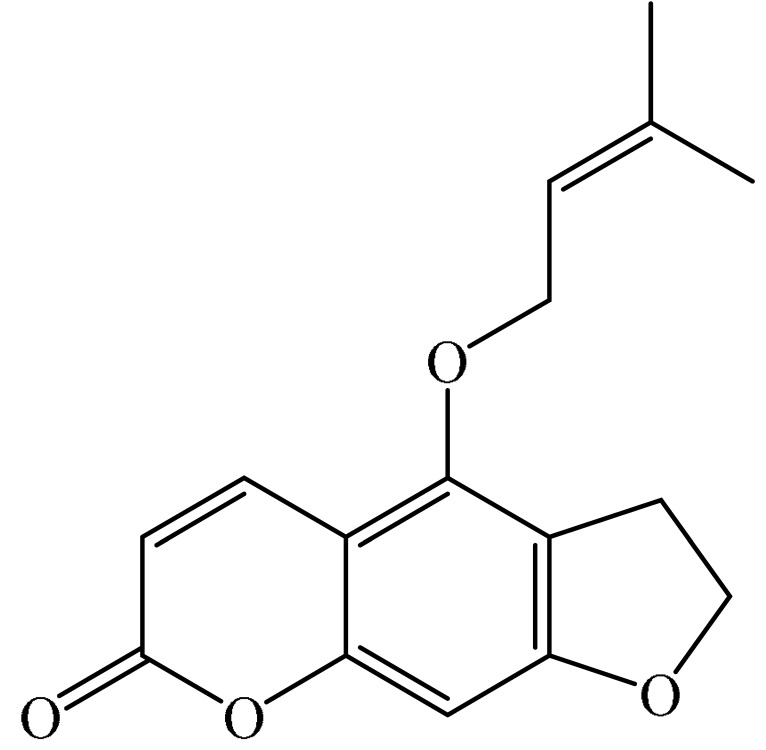 Isoimperatorin |
Lime, parsley | SGC-7901 | IC50 = 18.75 μg·mL−1 | SGC-7901 cell-induced xenograft model (mice) | 10 mg/kg (20 days) | G1-phase arrest; caspase 3,9 ↑; Bax↑, Bcl2 ↓, Survivin↓ | [32] |
| DU145 | 100 µM | — | — | G1-phase arrest | [33] | ||
| HCT-15 | IC50 = 5.6 ± 0.3 μg·mL−1 | — | — | ↓ cell viability | [23] | ||
| A549 (NSCLC) | IC50 = 12.2 ± 0.4 μg·mL−1 | — | — | ||||
| SK-OV-3 | IC50 = 6.8 ± 0.3 μg·mL−1 | — | — | ||||
| SK-MEL-2 | IC50 = 9.9 ± 0.2 μg·mL−1 | — | — | ||||
| XF498 | IC50 = 10.7 ± 0.3 μg·mL−1 | — | — | ||||
 Marmesin |
Broad bean, blackberry, raspberry | U937 | IC50 = 40 µM | Mice | 30mg/kg (30 days) | Bax↑, Bcl2 ↓, Bax/Bcl-2 ratio ↑; G2/M-phase arrest | [34] |
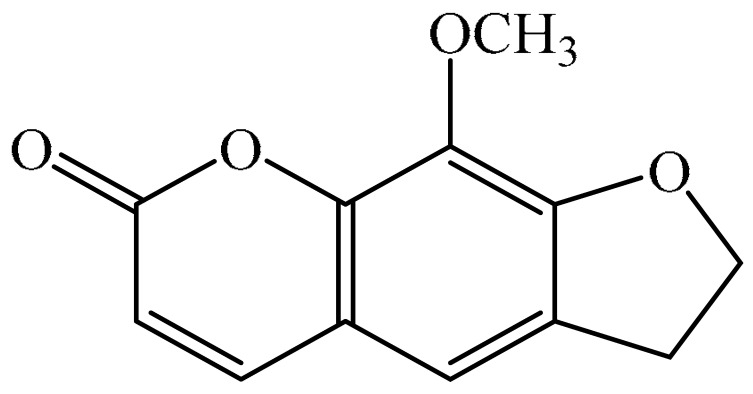 Methoxsalen/Xanthotoxin (8-MOP) |
Anise, carrot, caraway celeriac, celery, cumin, dill, grapefruit, lemon, lime, parsley, parsnip, turnip | HepG2 | 100 µM | — | — | Bax/Bcl-2 ratio ↑, MMP2 ↓, MMP9 ↓, ERK1/2 pathway inhibition, cyt c release ↑, AIF transposition ↑ | [35] |
| SK-N-AS and SW620 | IC50 = 56.3 µM for SK-N-AS and 88.5 µM for SW620 | — | — | Caspase-3,8,9↑PI3K/AKT pathway ↓, Bcl2 ↓, Bax/Bcl-2 ratio ↑ | [36] | ||
 Oxypeucedanin |
Lime, parsley | L5178Y (mouse T-cell lymphoma cells) | IC50 = 40.33 ± 0.63 µM | — | — | caspase 3,9 ↑; cyt c release ↑; Bcl2 ↓ | [37] |
| HCT-15 | IC50 = 3.4 ± 0.3 μg·mL−1 | — | — | ↓ cell viability | [23] | ||
| A549 (NSCLC) | IC50 = 9.5 ± 0.3 μg·mL−1 | — | — | ||||
| SK-OV-3 | IC50 = 19.3 ± 0.3 μg·mL−1 | — | — | ||||
| SK-MEL-2 | IC50 = 16.5 ± 0.2 μg·mL−1 | — | — | ||||
| XF498 | IC50 = 16.1 ± 0.5 μg·mL−1 | — | — | ||||
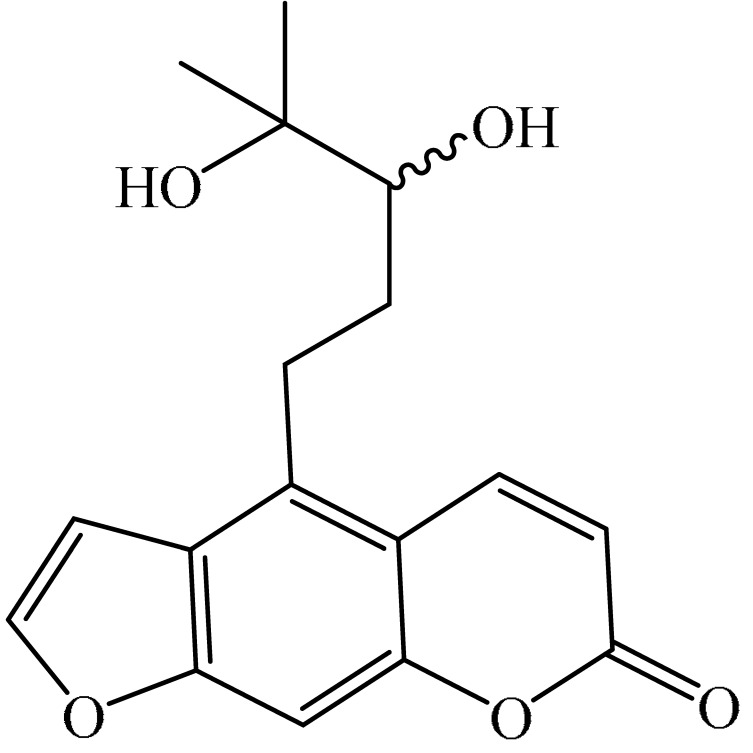 (+)-oxypeucedanin hydrate |
Angelica dahurica roots | A549, HCT-15, SK-MEL-2, SK-OV-3, XF498 | IC50 > 30 μg·mL−1 | — | — | ||
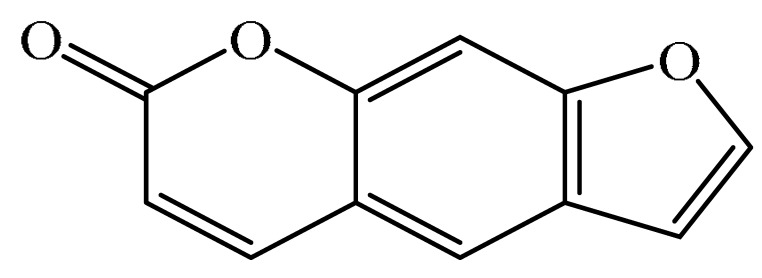 Psoralen |
Carrot, celeriac, celery, cilantro, cumin, dill, fig, grapefruit, lemon, lime, parsley, parsnip | KBv200 | 75.3% (80 μg·mL−1) | — | — | NF-κB inactivation G1/S phase arrest, c-FLIP, and IAP inhibition | [38] |
| K562 | 92.4% (80 μg·mL−1) | — | — | ||||
| MCF-7 | 17.32 ± 4.28% (8 μg·mL−1) | — | — | G1/G0 phase arrest | [39] | ||
| SMMC7721 | 40 μM | — | — | G1 phase arrest, cyclin E↓, Bax↑, Bcl2 ↓, ER stress, CHOP induction, GADD34↑, ATF4↑, GRP78↑, GRP94 |
[40] | ||
| MCF-7/ADR | IC10 = 8 μg/mL | P-gp efflux function inhibition | [41] | ||||
| IC50 = 25.59 ± 1.74 µg/mL | P-gp ATPase activity inhibition | [42] | |||||
| 43.0 µM | EMT inhibition | ||||||
| 107.5 µM | G0/G1 phase arrest | ||||||
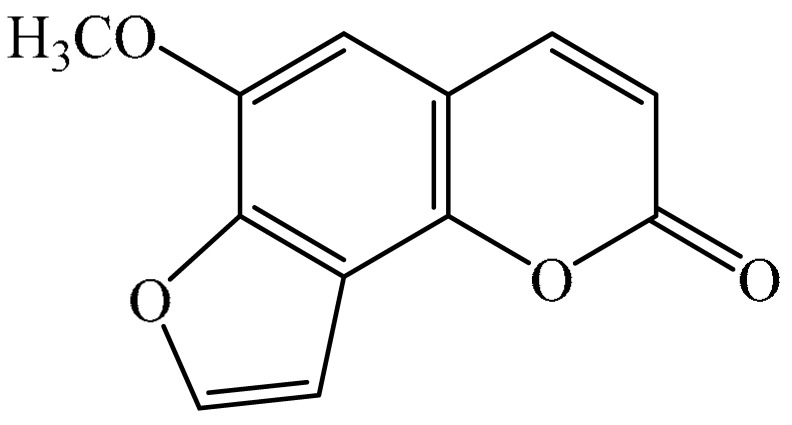 Sphondin |
Parsnip | A549 | 50 μM | — | — | NF-κB inactivation | [43] |
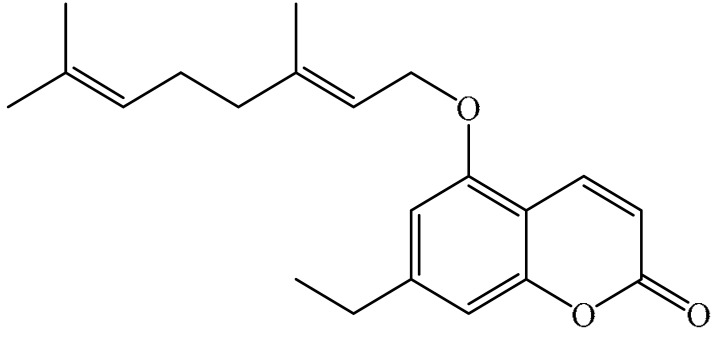 5-geranyloxy-7-methoxy-coumarin |
Lime | SW480 | 25 µM (67%) | — | — | caspase-3,8↑; Bcl2 ↓; p38 MAPK phosphorylation inhibition; G1/G0 phase arrest | [44] |
Human cancer cell lines: A549 (NSCLC), NCI-H460 (NSCLC), H23, and H1299 = lung cancer; Caki = renal carcinoma; DLD-1, LoVo, HCT-15, HT-29, HCT116, RKO, SW480 and SW620 = colorectal cancer; DU145 = prostate cancer; HL-60 = promyelocytic leukemia; HeLa and SiHa = cervical cancer; HepG2, Huh-7 and SMMC7721 = liver carcinoma; HT-1080 = fibrosarcoma; KBM-5, K562 = human chronic myeloid leukaemia; KBv200 = oral squamous carcinoma; MCF7 SKBR-3 and ZR-75 = breast cancer; SH-SY5Y and SK-N-AS = neuroblastoma; SK-MEL-2 = melanoma; SK-OV-3 = ovarian cancer; SGC-7901 = gastric cancer cell; U937 = leukemia; U87 and U251 = glioma cells; XF498 = CNS solid tumor; MCF-7/ADR = doxorubicin resistant derivatives of MCF-7 cells overexpressing P-gp; ↑ = increase; ↓ = decrease.
Figure 1.
A schema of different molecular mechanisms that are targeted by furanocoumarin. It shows several molecular singling pathways modulation that leads to autophagy, apoptosis, angiogenesis, and metastasis. Black lines: induce, and red lines: inhibit.
3. Bioavailability of Furocoumarins
Furanocoumarins are rapidly absorbed from food into the human bloodstream and detected in plasma within 2–15 min after administration [20], and distributed to the skin, blood, liver, brain, spleen, kidney, and testis. In plasma, furanocoumarins bind to albumins and other plasma proteins. Furanocoumarins are metabolized to psoralen and isopsoralen by intestinal bacteria in the digestive tract. Then, furanocoumarins are excreted into urine as hydroxylated or glucuronated products within 1 h after ingestion. They remain in urine as long as 24 h post-administration. It was also observed that furanocoumarins are converted to bergaptol before excretion [11,21,22].
A significant advance in the investigation of the anticancer properties of furanocoumarins was the revelation of their antiproliferative activity arresting cell-cycle capture and causing cell death [23,24,25]. At the cellular levels, furanocoumarins appear to affect actin filaments, which might be valuable in metastasis prevention [26].
4. Mechanistic Insights
4.1. NF-κB Inactivation
NF-κB and STAT3 inactivation or inhibition cause apoptosis and consequent ineffectiveness of anticancer treatments [23,24]. NF-κB and signal transducer and activator of transcription 3 (STAT3) association triggers inflammation and cancer [25]. Bergamottin enhances tumor necrosis factor (TNF) induced apoptosis in U87 and U251 via NF-κB and STAT3 inhibition [26]. The blocking of NF-κB activity by psoralen (80 μg/mL) leads to inhibition of FADD like IL-1β converting enzyme inhibitory protein (c-FLIP) and inhibitor of apoptosis proteins (IAP), activation of Bax, JNKs, and blocking G1/S phase in KBv200 and K562 [27].
MMP-2,9 decrement, E-cadherin increment, EMT inhibition, and JNK cascade activation are associated with NF-κB inactivation and result in antimetastatic behavior [28,29,30,31,32]. Angelicin inhibits A549 non-small-cell lung carcinoma (NSCLC) growth and metastasis by reducing MMP-2,9; increasing E-cadherin expression levels and JNK, and ERK activation [33]. Bergamottin inhibited the migration abilities of A549, H1299 [34]; HT-1080 cells [35] and human fibrosarcoma HT-1080 cells [36], by decreasing the phorbol 12-myristate 13-acetate (PMA)-initiated enactment of matrix metallo proteinase (MMP)-2,9; c-jun N-terminal kinase (JNK) phosphorylation and EMT inhibition through NF-κB inactivation. Psoralen give similar response in MCF-7/ADR cells [37]. Rac1 blocks drug-induced apoptosis by maintaining Bad in the phosphorylated state [38]. Inactivation of Rac 1 is also responsible for NF-κB inactivation [39]. Bergamottin exhibits antimetastatic behavior in U87 and U251 human glioma cells through Rac1 inactivation and MMP-9 downregulation [26].
In chronic inflammation, immune cells generate excessive ROS and RNS in the inflamed tissue and reinforce the NF-κB mediated inflammatory responses that can lead to tumorigenesis. Therefore, NF-κB down regulation is helpful in cancer prevention and treatment by exerting anti-inflammatory effect [40,41]. NF-κB expresses cytokines, chemokines, and also maintains the inflammatory response through persistent leukocyte activation [42,43]. Sphondin inhibits IL-1β-initiated-COX-2 by NF-κB inactivation in the A549 cell line [44]. Imperatorin reduced IL-6, -1β, and TNF-α discharge and inhibited iNOS and COX-2 by repressing NF-κB in RAW 264.7 (murine-macrophages-cell lines) [45,46]. Bergamottin, Bergapten and Psoralen inhibit ROS/NO generation for anti-inflammatory activity [35,47,48].
4.2. PI3K/Akt Inhibition
Activated PI3K/Akt contributes to (i) protection of cells from apoptosis, by inactivation of Bax, Bad, Bak, Bid, MDM2, caspase-9, and Bax and causes activation of cyclic AMP responsive element binding protein (CREB) to induce transcription of Bcl-2, (ii) regulation of cell metabolism; (iii) fatty acid synthesis. In apoptosis, cytosol Bax releases caspase-activating Cyt-c. The caspase-8 (extrinsic apoptosis) or -9 (intrinsic apoptosis), is activated which further activates caspase-3, essential to propagates apoptotic signal [49,50,51,52,53]. Cell shrinkage and chromatin condensation helps in apoptosis [54]. Activated caspase-3 stimulates inhibitor of caspase activated DNAse (ICAD) to release caspase-activated DNAse (CAD), which condenses the chromatin [55]. Angelicin in PC-3 cells [56] and bergamottin in A549 (NSCLC) cell lines [57] cause chromatin condensation. Imperatorin induced selective antitumor effects in SGC-7901 cells without causing too much cytotoxicity to the normal mouse fibroblast cells (3T3 cells). It also induced apoptosis, G1 phase arrest, DNA fragmentation, and downregulation of PI3K/Akt/m-TOR signaling pathway [58]. Methoxsalen (8-MOP) activated caspase-8 -9, Bax/Bcl-2 ratio upregulation, cytochrome-c (Cyt-c) release, and CREB phosphorylation decrement to down-regulates Bcl-2 for apoptosis in SW620 and SK-N-AS cells, through PI3K/Akt down-regulation [51]. Angelicin increases Bax, caspase-3, -9, decreases Bcl-2, Bcl-xL, Mcl-1 in A549 (NSCLC) cells [33], and SH-SY5Y cells [59] to induce intrinsic mitochondria-mediated apoptosis. Angelicin, and in combination, activated caspase-3 and decreased FADD like IL-1β converting enzyme inhibitory protein (c-FLIP) in Caki (renal carcinoma) cells to induce apoptosis [60]. Bergamottin induces apoptosis in human colon carcinoma cell line (RKO) and HT-29 cells by increasing caspase-3, 8, and 9; and PARP cleavage [61]. Bergapten inhibits breast cancer cell line (MCF-7) growth [62] and CRC cell viability [63] via inhibition of Akt. Bergaptol inducesMCF-7 cytotoxicity by the same mechanism [64]. Methoxsalen (8-MOP) inducesHepG2 cells apoptosis by Bax/Bcl-2 increment, MMPs decrement, and Cyt-c release and AIF transposition induction [65]. Imperatorinin duce’s both intrinsic and extrinsic apoptotic pathways by Bcl-2 protein expression downregulation, caspase-3, -7, -8, -9 activation, releases mitochondrial Cyt-c to the cytosol and cleaves poly (ADP-ribose) polymerase (PARP) in HT-29, HL-60 [52,66], SNU 449, HCT-15 [67], and HepG2 cells [68]. Isoimperatorin induces the apoptosis in SGC-7901 and in vivo xenograft model by Bax, caspase-3, -9 increment, and Survivin and Bcl-2 decrement in nude mice [69]. Marmesin inhibits colony formation and induces apoptosis in U937 cells by triggering Bax upregulation, Bcl-2 downregulation, and Bax/Bcl-2 ratio increment [70]. Byakangelicol, cnidicin, imperatorin, isoimperatorin, oxypeucedanin and (+)-oxypeucedanin hydrate from Angelica dahurica roots exert cytotoxicity in A549, HCT-15, SK-OV-3, SK-MEL-2, XF498 cells by similar mechanisms [71]. 5-geranyloxy-7-methoxycoumarin from lime suppressesSW480 cell proliferation by apoptosis through caspase-3, -8 activation, regulation of Bcl2, and p38 MAPK phosphorylation inhibition [72]. Psoralen causes Bax increment and attenuates Bcl-2 expression in SMMC7721 human hepatoma cells [73]. Liver X receptor (LXR) regulates lipid metabolism, inflammation and induces apoptosis through caspase-3 activation [74]. LXRs activation increases ABCA1 cholesterol transporters and inducible degrader of the low-density lipoprotein receptor (IDOL) in turn triggering low-density lipoprotein receptor (LDLR) degradation and reducing intracellular cholesterol, thereby reducing SREBPs, tumor growth, and survival. Highly expressed SREBPs play important roles in malignancies, connecting oncogenic signaling to lipid metabolism alterations, leading to rapid tumor growth. PI3K-Akt pathway is inhibited by LXRs [53,75]. Bergapten inhibits liver carcinogenesis (HepG2) by activating LXRs, inhibiting PI3K/Akt that reduced SREBP-1, fatty acid synthase (FASN), stearoyl-CoA desaturase-1 (SCD1), thereby preventing fatty acid synthesis and tumor growth [53].
The antitumor effects of angelicin involves decreased expression of p-VEGFR2 and PI3K/Akt signaling inhibition in HepG2 and Huh-7 cells. In the same study, angelicin was shown to decrease p-VEGFR in mouse liver orthotopic xenograft model [17]. Bergamottin suppresses TGF-β initiated EMT and the cell invasive potential by PI3K, Akt, and mTOR kinases [35].
4.3. p53 Modulation
The p53 controls cell cycle progression and regulates apoptosis and autophagy [76]. p53 activation promotes p21 and p27 expression, which restrain cyclin E and Cdk2 activity, thereby cause cell cycle phase arrest [77]. Bergapten increases p53 activity that induces p21 transcription, which, in turn, inhibits G2/M phase in HepG2 cells [11]; triggers G1 arrest in A549, NCI H460 [78] and MCF-7 cells [62]. p53 protein intervenes in two major apoptotic pathways: an “extrinsic pathway” induced by death receptors (TNF proteins such as DR4 and DR5) and an “intrinsic pathway” that regulates Family Bcl-2 proteins [5]. Bergapten (30 and 50 μM) decreased CRC (colorectal cancer) cells’ viability by apoptosis via upregulation of p53, p21, and PTEN [63]. Furanocoumarin A from Fructus liquidambaris induces the apoptosis in A549 by increasing p53 [79]. Imperatorin significantly upregulates p53 and p21, which subsequently results in Mcl-1 down-regulation and Bax up-regulation in H23 human lung cancer cell [80] and HT 29 colon cancer cells [52] to inhibit their growth. Psoralen upregulates p21, waf and p53 in cells SKBR-3 MCF-7 cells, causing apoptosis [81,82]. Similarly, 5-geranyloxy-7-methoxy coumarin induces apoptosis in SW480 cells through the activation of tumor suppressor gene p53 [72].
Psoralen inhibits SMMC7721 cells (human hepatoma cell line) proliferation by ER stress induction by apoptosis. During ER-stress, glucose regulatory protein 78 (GRP78), GRP94, protein kinase R-like ER kinase (PERK), inositol requiring enzyme 1 (IRE1), and activating transcription factor-6 (ATF6), growth arrest and DNA damage inducible protein 34 (GADD34), and ATF4 increment can promote C/E B P homologous protein (CHOP) and high expression of CHOP, thereby inhibiting Bcl-2 and promoting apoptosis [73].
Psoralen causes exosomes formation and secretion reduction through p53 and PPAR activation in MCF-7/ADR cells, which showed its role against chemotherapy resistance in breast cancer [83].
The antioxidant functions of p53 protein also induces apoptosis and autophagy [5,84]. Imperatorin increases p53, in turn, exerting antioxidant effects that may contribute to its anticancer effects [85,86].
4.4. Cell Cycle Arrest
Cell cycle progression or arrest is related to cyclin-A, -B1, -D1, -E1 and cyclin B1, cyclin E1, Cdc2, Cdk2 and Wnt/β-catenin [87,88,89]. Angelicin suppresses proliferation of A549 cells; HeLa and SiHa cells by promoting G2/M and G1/G0 phase arrest respectively by cyclin-B1, -E1 and Cdc2 downregulation [33,90].Bergamottin arrests HT-29, RKO and A549 (NSCLC) cells at G2/M by cyclin-A, -B1 and Cdc2 depletion [57,61]. Bergapten (5-MOP) blocks G2/M phase in Hep-G2 with the inhibition of Cdk1 [91]. Bergapten (30 and 50 μM) instigated the G0/G1 and sub-G1 stage capture in CRC cells by a decrease of cyclin E/Cdk2 [63]. Bergaptol arrests G1-phase in MCF-7 [64]; Imperatorin in HT 29 and SGC-7901 cells [52,58] and isoimperatorin in DU145 and SGC-790 cells by increasing Cip1/p21 and Kip1/p27 expression and disrupting Cdk4 kinase synthesis [69,92]. Marmesin captures G2/M and cell migration in U937 [70]. Psoralen arrests at G1 phase in SMMC7721 by Cyclin-E1 reduction [73]. Psoralen arrests G0/G1 by deregulation of Wnt/β-catenin in MCF-7 [93].
4.5. Autophagy
Increase in autophagy results in cell growth inhibition and apoptosis [94,95]. Angelicin accumulated microtubule-associated LC3B and upregulated Atg-3,7 and 12-5 in HeLa and SiHa cells [90]. PTEN is downregulated to corneal tumors [96]. Bergapten exhibited autophagy in MCF-7 and ZR-75 by PTEN, AMBRA, Beclin1, PI3KIII and, UVRAG up-regulation and LC3-II conversion [97]. Feroniellin-A from Feroniella lucida roots initiates autophagy in A549 by LC3-II conversion; Beclin-1 and Atg-5 enhanced expression [98].
4.6. Antioxidant
Oxidative stress is caused by ROS accumulation and high ROS concentration is demanded by cancerous cells. Anticancer phytochemicals with antioxidants properties reduce developing cancer risks [45,99]. Bergamottin, bergaptol, methoxsalen [100], bergapten [101], imperatorin [102], oxypeucedanin [103] and psoralen [104] have been reported to possess antioxidant activities. N-nitrosodiethylamine (NDEA) causes oxidative stress and responsible for the carcinogenic effect. Bergapten has shown to possess anticancer potential in vivo against NDEA-induced liver cancer via antioxidant effects [53]. Hypoxia is a noteworthy component of tumor malignant growth, and it activates hypoxia inducible factor (HIF), thus increasing tumor survival and proliferation [85]. Antioxidants inhibit HIF-1 α activity by scavenging free radicals [105]. Imperatorin has been shown to inhibitHIF-1 in HCT116 due to its antioxidant behavior and mTOR/p70S6K/4E-BP1 and MAPK downregulation [86].
5. Role in MDR Cancers
Cancer cell defiance to chemotherapy is one of the significant deterrents for counter cancer medications due to the involvement of different mechanisms. The main causes are related to the increment of multidrug efflux pumps, including P-gp by tumor cells, and showed MDR. Coumarins have a significant role in MDR inversion [106,107,108].
Psoralen inverts the P-gp-instigated MDR in MCF-7/ADR by repressing the efflux capacity of P gp [108] and by hindrance of P-gp ATPase activity [37]. Similarly, isopimpinellin (IC50 value 26 µM) and Phellopterin (IC50 value 8 µM) exhibited cytotoxic activity against MDR HL-60/MX2 (human promyelocytic leukemia cells) and CEM/C1 (human lymphoblastic leukemia cells) respectively [109]. Feroniellin A reduces MDR in A549 cell lines by decreasing P-gp [98]. MDR1rapidly pumps out anticancer drugs, decreases intracellular drug concentrations and leads to the failure of anticancer therapeutics [110]. Similarly, BCRP and MRP overexpression participates in MDR [111,112]. Bergapten and methoxsalen showed cytotoxicity in MDR1, MRP2 BCRP overexpressing gastric (EPG85.257RDB), ovarian (A2780RCIS) and breast (MCF7MX) cancer cell lines which showed reticence of MDR1, BCRP, and MRP efflux functions [113].
ETRα positive and estrogen dependence are seen in 70% of breast cancers. ETRα depletion during initial stages of breast cancer is a potent anticancer approach [114]. Xanthotoxol, bergapten, angelicin, psoralen and isoimperatorin antagonized ETRα activity in MCF-7 cells with IC50 values of 0.72, 1.18, 11.02, 24.08 and 54.32 μM, respectively [115].
Exosomes, secreted from tumor cells to promote tumor progression, such as metastasis and MDR, activate sequestration of anticancer drugs by MDR-1 and P-gp [116]. Psoralen significantly reduces the number of exosomes, which correlates with increased MCF-7/ADR cells’ sensitivity for apoptosis under the influence of chemotherapy. Similar observations were seen in A 549/D16 lung cancer cell lines [11,83,117].
6. Furanocoumarins as Adjuvant with Other Anticancer Agents
Invasion and angiogenesis are important targets of FC (Figure 2). In a study, given that bergamottin (50 μM)-potentiated simvastatin (SV) inhibits TNF-induced NF-κB activation and IκBα deterioration, cell-cycle capture in S-phase by boost of p21 and p27 in KBM-5 cells. This impact of co-treatment is associated with decrease incyclin D1 (cell proliferation), Bcl-2, cIAP-1, Bcl-xL and survivin (cell survival), MMP-9 (invasion), and VEGF (angiogenesis) which are directed by NF-κB. CYP P450 34A inhibition by bergamottin enhances SV bioavailability in KBM-5 to synergize SV effects [35,118].Cytochrome P450 upregulation in cancer makes it one of the effective strategy against it. CYP P450 inhibition by furanocoumarins and other phytoconstituents leads to anticarcinogenic effects, down regulating MDR and prolonging the t1/2 of other anticancer drugs [119,120]. Bergamottin, DHBG, bergapten, and bergaptol inhibit CYP P450 34A to potentiate vinblastine effects [121]. Bergamottin, imperatorin, and isopimpinellin repressed CYP P450-1A1, -1A2, -3A4, and -1B1 (involve in carcinogen metabolism), in the MCF-7 cell lines [122]. MDR has been linked to BCRP, MRP, and MDR1 increase that expel cisplatin, daunorubicin, and mitoxantrone are very common in cancer therapeutics [113]. Bergapten and methoxsalen are capable of averting mitoxantrone, cisplatin, and daunorubicin binding to MDR1, BCRP, and MRP and, therefore, impeding their cellular efflux [113]. Bergamottin, DHBG, bergapten, and bergaptol from grapefruit juice inhibit P-gp and MRP2 mediated vinblastine efflux [121]. Long-term use of tamoxifen in breast cancer leads to MDR and an increased risk of endometrial carcinogenesis [123]. Bergapten degrades and depletes ETRα from MCF-7 tamoxifen-resistant cells by inducing SMAD4 protein to block mitogenic signals [62]. The anticancer effects of doxorubicin in HeLa cells are enhanced by Imperatorin via Mcl-1 down-regulation [124]. Imperatorin (100 μM) effectively increasing autophagy in HeLa cells in response to cisplatin (2 μM) by microtubule-associated protein 1A/1B-light chain 3 (LC3) cleavage and the inhibition of Hsp27 and Hsp72 [125]. Imperatorin potentiates the cytotoxicity of cisplatin in hepatocellular carcinoma (HCC) cells (HepG2, HepG3B, PLC, Huh7) by downregulating Mcl-1 expression [126].
Figure 2.
A schema of anti-angiogenesis effects of furanocoumarin. FC via activation/inhibition of a sequences of cellular and molecular pathways exerts its anti-angiogenesis effects. Black lines: induce, and red lines: inhibit.
7. Furanocoumarins and Cancer Risks
PUVA therapy (photoactivated psoralens) is beneficial for patients with vitiligo, psoriasis, and skin diseases. PUVA activates caspase-3, -8 and -9 in Jurkat (human tumor T-cell line) [127]. PUVA, the photoactivated psoralens (5-MOP and 8-MOP) induce apoptosis in MCF-7, ZR-75 and SKBR-3 by caspase and p53 upregulation, PI3K/AKT downregulation and effective against breast hormone-responsive cancers [128]. PUVA arrest G2/M phase by phospho-Chk1 increment and phospho-Cdc2 decrement in B16F10 murine melanoma cell line [129]. Unfortunately, it is linked toa risk of basal cell, squamous cell, and non-melanoma skin cancers [130,131]. PUVA has been approved by the FD, [132]. PUVA is ideal for superficial applications only, due to low penetration into deep tissues. Therefore, X-PACT has been introduced, which at low X-ray doses photoactivates psoralens and hence mitigates the low penetration problem and adverse effects of PUVA [133].
8. Conclusions
Chemotherapy and radiation are the staples for treatment of malignant growth, however, both have serious adverse health symptoms. It is known that tumors have developed many mechanisms at the molecular level enabling cell survival during chemotherapy. Therefore, it is essential to develop novel pharmaceuticals with increased efficacy and reduced toxicity. This review highlights the potential for furanocoumarins to be clinically beneficial in cancer, particularly given their specificity to tumor cells (while sparing normal cells). In vitro investigations have shown that furanocoumarins affect a range of cellular mechanisms, such as apoptosis, autophagy, and cell cycle arrest. ER stress induction mainly caused by NF-κB inactivation, PI3K/Akt inhibition, and p53 modulation. Furanocoumarins are also effective in different MDR cancers that are the main cause of anticancer therapeutics failure. Compounds in this class have also have been shown to positively synergize with commonly used anticancer drugs. The fast absorption of furanocoumarins from food into the human bloodstream is also noteworthy [134]. Furanocoumarins, by inhibiting CYP P450 3A4, not only have anticancer properties but also when co-administered with a low bioavailability anticancer compound can increase oral bioavailability [135]. Thus, as to improve genuine treatments for various sorts of tumors, nanomedicine has developed new strategies coordinated to build the efficacy of medications focusing on tumors and limit their side effects [136,137]. Furanocoumarin-loaded lipid-polymer-hybrid-nanoparticles represent an additional option for sustained release of these molecules to improve efficacy and synergistic effects with other anticancer agents and against MDR cancers [108,138,139]. To date, most focus has been on in vitro studies, making it hard to reach solid conclusions on the efficacy of furanocoumarins in vivo. Nonetheless, studies aimed at characterizing furanocoumarin’s efficacy in vivo as well as clinical studies are encouraging, supporting the need for future studies to better characterize furanocoumarin’s potential as efficacious anticancer treatment modalities.
Author Contributions
Conceptualization, H.K. and M.A.; drafting the manuscript, S.A., H.K., M.A., H.M., and E.K.A.; review and editing the paper: H.K., M.A., and R.C.; revising S.A., H.K., M.A., H.M., E.K.A, and R.C. All authors have read and agreed to the published version of the manuscript.
Funding
This research received no external funding.
Conflicts of Interest
The authors declare no conflict of interest.
References
- 1.Singh S., Sharma B., Kanwar S.S., Kumar A. Lead phytochemicals for anticancer drug development. Front. Plant Sci. 2016;7:1667. doi: 10.3389/fpls.2016.01667. [DOI] [PMC free article] [PubMed] [Google Scholar]
- 2.Ashraf M.A. Phytochemicals as potential anticancer drugs: Time to Ponder Nature’s Bounty. BioMed Res. Int. 2020;2020:8602879. doi: 10.1155/2020/8602879. [DOI] [PMC free article] [PubMed] [Google Scholar]
- 3.Khattak S., Khan H. Anti-cancer potential of phyto-alkaloids: A prospective review. Curr. Cancer Ther. Rev. 2016;12:66–75. doi: 10.2174/1573394712666160617081638. [DOI] [Google Scholar]
- 4.Rauf A., Khan R., Khan H., Tokuda H. Cytotoxic, antitumor-promoting and inhibition of protein denaturation effects of flavonoids, isolated from Potentilla evestita Th. Wolf. Nat. Prod. Res. 2015;29:1775–1778. doi: 10.1080/14786419.2014.999336. [DOI] [PubMed] [Google Scholar]
- 5.Khan H., Reale M., Ullah H., Sureda A., Tejada S., Wang Y., Zhang Z.-J., Xiao J. Anti-cancer effects of polyphenols via targeting p53 signaling pathway: Updates and future directions. Biotechnol. Adv. 2020;38:107385. doi: 10.1016/j.biotechadv.2019.04.007. [DOI] [PubMed] [Google Scholar]
- 6.Spector D. Optimizing Cancer Survivors’ Health: The Role of Lifestyle Behaviors. J. Nurse Pract. 2018;14:323–329. doi: 10.1016/j.nurpra.2017.12.007. [DOI] [Google Scholar]
- 7.Patridge E.V., Gareiss P., Kinch M., Hoyer D. An analysis of FDA-approved drugs: Natural products and their derivatives. Drug Discov. Today. 2016;21:204–207. doi: 10.1016/j.drudis.2015.01.009. [DOI] [PubMed] [Google Scholar]
- 8.Faraone I., Sinisgalli C., Ostuni A., Armentano M.F., Carmosino M., Milella L., Russo D., Labanca F., Khan H. Astaxanthin anticancer effects are mediated through multiple molecular mechanisms: A systematic review. Pharmacol. Res. 2020;155:104689. doi: 10.1016/j.phrs.2020.104689. [DOI] [PubMed] [Google Scholar]
- 9.Del Río J.A., Diaz L., García-Bernal D., Blanquer M., Ortuño A., Correal E., Moraleda J.M. Furanocoumarins: Biomolecules of therapeutic interest. In: Rahman A., editor. Studies in Natural Products Chemistry. Volume 43. Elsevier; Amsterdam, The Netherlands: 2014. pp. 145–195. [Google Scholar]
- 10.Melough M.M., Cho E., Chun O.K. Furocoumarins: A review of biochemical activities, dietary sources and intake, and potential health risks. Food Chem. Toxicol. 2018;113:99–107. doi: 10.1016/j.fct.2018.01.030. [DOI] [PubMed] [Google Scholar]
- 11.Sumorek-Wiadro J., Zając A., Maciejczyk A., Jakubowicz-Gil J., Joanna S.-W., Adrian Z., Aleksandra M., Joanna J.-G. Furanocoumarins in anticancer therapy-For and against. Fitoterapia. 2020;142:104492. doi: 10.1016/j.fitote.2020.104492. [DOI] [PubMed] [Google Scholar]
- 12.Olomola T.O., Mosebi S., Klein R., Traut-Johnstone T., Coates J., Hewer R., Kaye P.T. Novel furocoumarins as potential HIV-1 integrase inhibitors. Bioorg. Chem. 2014;57:1–4. doi: 10.1016/j.bioorg.2014.07.008. [DOI] [PubMed] [Google Scholar]
- 13.Pynam H., Dharmesh S.M. Antioxidant and anti-inflammatory properties of marmelosin from Bael (Aegle marmelos L.); Inhibition of TNF-α mediated inflammatory/tumor markers. Biomed. Pharmacother. 2018;106:98–108. doi: 10.1016/j.biopha.2018.06.053. [DOI] [PubMed] [Google Scholar]
- 14.Melis C., Distinto S., Bianco G., Meleddu R., Cottiglia F., Fois B., Taverna D., Angius R., Alcaro S., Ortuso F., et al. Targeting Tumor Associated Carbonic Anhydrases IX and XII: Highly Isozyme Selective Coumarin and Psoralen Inhibitors. ACS Med. Chem. Lett. 2018;9:725–729. doi: 10.1021/acsmedchemlett.8b00170. [DOI] [PMC free article] [PubMed] [Google Scholar]
- 15.Niu C., Lu X., Aisa H.A. Preparation of novel 1,2,3-triazole furocoumarin derivatives via click chemistry and their anti-vitiligo activity. RSC Adv. 2019;9:1671–1678. doi: 10.1039/C8RA09755K. [DOI] [PMC free article] [PubMed] [Google Scholar]
- 16.Niu C., Yin L., Aisa H.A. Novel Furocoumarin Derivatives Stimulate Melanogenesis in B16 Melanoma Cells by Up-Regulation of MITF and TYR Family via Akt/GSK3β/β-Catenin Signaling Pathways. Int. J. Mol. Sci. 2018;19:746. doi: 10.3390/ijms19030746. [DOI] [PMC free article] [PubMed] [Google Scholar]
- 17.Wang F., Li J., Li R., Pan G., Bai M., Huang Q. Angelicin inhibits liver cancer growth in vitro and in vivo. Mol. Med. Rep. 2017;16:5441–5449. doi: 10.3892/mmr.2017.7219. [DOI] [PMC free article] [PubMed] [Google Scholar]
- 18.Guillon C., Jan Y.-H., Foster N., Ressner J., Heck D.E., Laskin J.D., Heindel N.D. Synthetically modified methoxsalen for enhanced cytotoxicity in light and dark reactions. Bioorg. Med. Chem. Lett. 2019;29:619–622. doi: 10.1016/j.bmcl.2018.12.048. [DOI] [PMC free article] [PubMed] [Google Scholar]
- 19.Carbone A., Montalbano A., Spanò V., Musante I., Galietta L.J., Barraja P. Furocoumarins as multi-target agents in the treatment of cystic fibrosis. Eur. J. Med. Chem. 2019;180:283–290. doi: 10.1016/j.ejmech.2019.07.025. [DOI] [PubMed] [Google Scholar]
- 20.Fujioka T., Furumi K., Fujii H., Okabe H., Mihashi K., Nakano Y., Matsunaga H., Katano M., Mori M. Antiproliferative constituents from Umbelliferae plants. V. A new furanocoumarin and falcarindiol furanocoumarin ethers from the root of Angelica japonica. Chem. Pharm. Bull. 1999;47:96–100. doi: 10.1248/cpb.47.96. [DOI] [PubMed] [Google Scholar]
- 21.Gawron A., Glowniak K. Cytostatic activity of coumarins in vitro. Planta Med. 1987;53:526–529. doi: 10.1055/s-2006-962801. [DOI] [PubMed] [Google Scholar]
- 22.Widelski J., Kukula-Koch W., Baj T., Kedzierski B., Fokialakis N., Magiatis P., Pozarowski P., Roliński J., Graikou K., Chinou I. Rare Coumarins Induce Apoptosis, G1 Cell Block and Reduce RNA Content in HL60 Cells. Open Chem. 2017;15:1–6. doi: 10.1515/chem-2017-0001. [DOI] [Google Scholar]
- 23.Godwin P., Baird A.-M., Heavey S., Barr M., O’Byrne K.J., Gately K.A. Targeting Nuclear Factor-Kappa B to Overcome Resistance to Chemotherapy. Front. Oncol. 2013;3:120. doi: 10.3389/fonc.2013.00120. [DOI] [PMC free article] [PubMed] [Google Scholar]
- 24.Aoki Y., Feldman G.M., Tosato G. Inhibition of STAT3 signaling induces apoptosis and decreases survivin expression in primary effusion lymphoma. Blood. 2003;101:1535–1542. doi: 10.1182/blood-2002-07-2130. [DOI] [PubMed] [Google Scholar]
- 25.Dong Z., Bode A.M., Dong Z. Breaking the NF-κB and STAT3 alliance inhibits inflammation and pancreatic tumorigenesis. Cancer Prev. Res. 2010;3:1379–1381. doi: 10.1158/1940-6207.CAPR-10-0251. [DOI] [PMC free article] [PubMed] [Google Scholar]
- 26.Luo W., Song Z., Sun H., Liang J., Zhao S. Bergamottin, a natural furanocoumarin abundantly present in grapefruit juice, suppresses the invasiveness of human glioma cells via inactivation of Rac1 signaling. Oncol. Lett. 2018;15:3259–3266. doi: 10.3892/ol.2017.7641. [DOI] [PMC free article] [PubMed] [Google Scholar]
- 27.Wang Y., Hong C., Zhou C., Xu D., Qu H.-B. Screening antitumor compounds psoralen and isopsoralen from Psoralea corylifolia L. seeds. Evid.-Based Complement. Altern. Med. 2011;2011:363052. doi: 10.1093/ecam/nen087. [DOI] [PMC free article] [PubMed] [Google Scholar]
- 28.Augustin S., Berard M., Kellaf S., Peyri N., Fauvel-Lafève F., Legrand C., He L., Crépin M. Matrix metalloproteinases are involved in both type I (apoptosis) and type II (autophagy) cell death induced by sodium phenylacetate in MDA-MB-231 breast tumour cells. Anticancer Res. 2009;29:1335–1343. [PubMed] [Google Scholar]
- 29.Chase A.J., Bond M., Crook M.F., Newby A. Role of nuclear factor-kappa B activation in metalloproteinase-1, -3, and -9 secretion by human macrophages in vitro and rabbit foam cells produced in vivo. Arter. Thromb. Vasc. Biol. 2002;22:765–771. doi: 10.1161/01.ATV.0000015078.09208.92. [DOI] [PubMed] [Google Scholar]
- 30.Artacho-Cordón F., Ríos-Arrabal S., Lara P., Artacho-Cordón A., Calvente I., Nuñez M. Matrix metalloproteinases: Potential therapy to prevent the development of second malignancies after breast radiotherapy. Surg. Oncol. 2012;21:e143–e151. doi: 10.1016/j.suronc.2012.06.001. [DOI] [PubMed] [Google Scholar]
- 31.Escárcega R.O., Fuentes-Alexandro S., García-Carrasco M., Gatica A., Zamora A. The Transcription Factor Nuclear Factor-kappa B and Cancer. Clin. Oncol. 2007;19:154–161. doi: 10.1016/j.clon.2006.11.013. [DOI] [PubMed] [Google Scholar]
- 32.Papa S., Zazzeroni F., Pham C.G., Bubici C., Franzoso G. Linking JNK signaling to NF-B: A key to survival. J. Cell Sci. 2004;117:5197–5208. doi: 10.1242/jcs.01483. [DOI] [PubMed] [Google Scholar]
- 33.Li G., Song X., He Y., Yao J., Huang C., Deng Y., Xie S., Ren J., Jin M., Liu H. Angelicin inhibits human lung carcinoma A549 cell growth and migration through regulating JNK and ERK pathways. Oncol. Rep. 2016;36:3504–3512. doi: 10.3892/or.2016.5166. [DOI] [PubMed] [Google Scholar]
- 34.Ko J.H., Nam D., Um J.Y., Jung S.H., Sethi G., Ahn K.S. Bergamottin Suppresses Metastasis of Lung Cancer Cells through Abrogation of Diverse Oncogenic Signaling Cascades and Epithelial-to-Mesenchymal Transition. Molecules (Basel, Switzerland) 2018;23:1601. doi: 10.3390/molecules23071601. [DOI] [PMC free article] [PubMed] [Google Scholar]
- 35.Ko J.-H., Arfuso F., Sethi G., Ahn K.S. Pharmacological Utilization of Bergamottin, Derived from Grapefruits, in Cancer Prevention and Therapy. Int. J. Mol. Sci. 2018;19:4048. doi: 10.3390/ijms19124048. [DOI] [PMC free article] [PubMed] [Google Scholar]
- 36.Hwang Y.P., Yun H.J., Choi J.H., Kang K.W., Jeong H.G. Suppression of phorbol-12-myristate-13-acetate-induced tumor cell invasion by bergamottin via the inhibition of protein kinase Cδ/p38 mitogen-activated protein kinase and JNK/nuclear factor-κB-dependent matrix metalloproteinase-9 expression. Mol. Nutr. Food Res. 2009;54:977–990. doi: 10.1002/mnfr.200900283. [DOI] [PubMed] [Google Scholar]
- 37.Wang X., Cheng K., Han Y., Zhang G., Dong J., Cui Y., Yang Z. Effects of psoralen as an anti-tumor agent in human breast cancer MCF-7/ADR cells. Biol. Pharm. Bull. 2016;39:815–822. doi: 10.1248/bpb.b15-00957. [DOI] [PubMed] [Google Scholar]
- 38.Embade N., Valerón P.F., Aznar S., López-Collazo E., Lacal J.C. Apoptosis Induced by Rac GTPase Correlates with Induction of FasL and Ceramides Production. Mol. Biol. Cell. 2000;11:4347–4358. doi: 10.1091/mbc.11.12.4347. [DOI] [PMC free article] [PubMed] [Google Scholar]
- 39.Gastonguay A., Berg T., Hauser A.D., Schuld N., Lorimer E., Williams C.L. The role of Rac1 in the regulation of NF-kappaB activity, cell proliferation, and cell migration in non-small cell lung carcinoma. Cancer Biol. Ther. 2012;13:647–656. doi: 10.4161/cbt.20082. [DOI] [PMC free article] [PubMed] [Google Scholar]
- 40.Rayburn E.R., Ezell S.J., Zhang R. Anti-Inflammatory Agents for Cancer Therapy. Mol. Cell. Pharmacol. 2009;1:29–43. doi: 10.4255/mcpharmacol.09.05. [DOI] [PMC free article] [PubMed] [Google Scholar]
- 41.Khan H., Ullah H., Castilho P.C.M.F., Gomila A.S., D’Onofrio G., Filosa R., Wang F., Nabavi S.M., Daglia M., Silva A.S., et al. Targeting NF-kappaB signaling pathway in cancer by dietary polyphenols. Crit. Rev. Food Sci. Nutr. 2019;12:1–11. doi: 10.1080/10408398.2019.1661827. [DOI] [PubMed] [Google Scholar]
- 42.Lawrence T. The nuclear factor NF-kappaB pathway in inflammation. Cold Spring Harb Perspect Biol. 2009;1:a001651. doi: 10.1101/cshperspect.a001651. [DOI] [PMC free article] [PubMed] [Google Scholar]
- 43.Ahmed S., Khan H., Fratantonio D., Hasan M.M., Sharifi S., Fathi N., Ullah H., Rastrelli L., Sharifi S. Apoptosis induced by luteolin in breast cancer: Mechanistic and therapeutic perspectives. Phytomedicine. 2019;59:152883. doi: 10.1016/j.phymed.2019.152883. [DOI] [PubMed] [Google Scholar]
- 44.Yang L.-L., Liang Y.C., Chang C.W., Lee W.-S., Kuo C.T., Wang C.C., Lee H.-M., Lin C.-H. Effects of sphondin, isolated from Heracleum laciniatum, on IL-1beta-induced cyclooxygenase-2 expression in human pulmonary epithelial cells. Life Sci. 2002;72:199–213. doi: 10.1016/S0024-3205(02)02173-2. [DOI] [PubMed] [Google Scholar]
- 45.Nasser M., Zhu S., Hu H., Huang H., Guo M., Zhu P. Effects of imperatorin in the cardiovascular system and cancer. Biomed. Pharmacother. 2019;120:109401. doi: 10.1016/j.biopha.2019.109401. [DOI] [PubMed] [Google Scholar]
- 46.Zhang X., Li W., Abudureheman A., Cheng T., Peng P. Imperatorin possesses notable anti-inflammatory activity in vitro and in vivo through inhibition of the NF kappa B pathway. Mol. Med. Rep. 2017;16:8619–8626. doi: 10.3892/mmr.2017.7706. [DOI] [PMC free article] [PubMed] [Google Scholar]
- 47.Yang Y., Zheng K., Mei W., Wang Y., Yu C., Yu B., Deng S., Hu J. Anti-inflammatory and pro resolution activities of bergapten isolated from the roots of Ficus hirta in an in vivo zebrafish model. Biochem. Biophys. Res. Commun. 2018;496:763–769. doi: 10.1016/j.bbrc.2018.01.071. [DOI] [PubMed] [Google Scholar]
- 48.Li X., Yu C., Hu Y., Xia X., Liao Y., Zhang J., Chen H., Lu W., Zhou W., Song Z. New application of psoralen and angelicin on periodontitis with anti-bacterial, anti-inflammatory, and osteogenesis effects. Front. Microbiol. 2018;8:178. doi: 10.3389/fcimb.2018.00178. [DOI] [PMC free article] [PubMed] [Google Scholar]
- 49.A West K., Castillo S.S., Dennis P.A. Activation of the PI3K/Akt pathway and chemotherapeutic resistance. Drug Resist. Updat. 2002;5:234–248. doi: 10.1016/S1368-7646(02)00120-6. [DOI] [PubMed] [Google Scholar]
- 50.Nicholson K.M., Anderson N.G. The protein kinase B/Akt signalling pathway in human malignancy. Cell Signal. 2002;14:381–395. doi: 10.1016/S0898-6568(01)00271-6. [DOI] [PubMed] [Google Scholar]
- 51.Bartnik M., Sławińska-Brych A., Żurek A., Kandefer-Szerszeń M., Zdzisińska B. 8-methoxypsoralen reduces AKT phosphorylation, induces intrinsic and extrinsic apoptotic pathways, and suppresses cell growth of SK-N-AS neuroblastoma and SW620 metastatic colon cancer cells. J. Ethnopharmacol. 2017;207:19–29. doi: 10.1016/j.jep.2017.06.010. [DOI] [PubMed] [Google Scholar]
- 52.Zheng Y.M., Lu A.X., Shen Z., Kwok A.H.Y., Ho W.S. Imperatorin exhibits anticancer activities in human colon cancer cells via the caspase cascade. Oncol. Rep. 2016;35:1995–2002. doi: 10.3892/or.2016.4586. [DOI] [PubMed] [Google Scholar]
- 53.Pattanayak S.P., Bose P., Sunita P., Siddique M.U.M., Lapenna A. Bergapten inhibits liver carcinogenesis by modulating LXR/PI3K/Akt and IDOL/LDLR pathways. Biomed. Pharmacother. 2018;108:297–308. doi: 10.1016/j.biopha.2018.08.145. [DOI] [PubMed] [Google Scholar]
- 54.Toné S., Sugimoto K., Tanda K., Suda T., Uehira K., Kanouchi H., Samejima K., Minatogawa Y., Earnshaw W.C. Three distinct stages of apoptotic nuclear condensation revealed by time-lapse imaging, biochemical and electron microscopy analysis of cell-free apoptosis. Exp. Cell Res. 2007;313:3635–3644. doi: 10.1016/j.yexcr.2007.06.018. [DOI] [PMC free article] [PubMed] [Google Scholar]
- 55.Elmore S.A. Apoptosis: A Review of Programmed Cell Death. Toxicol. Pathol. 2007;35:495–516. doi: 10.1080/01926230701320337. [DOI] [PMC free article] [PubMed] [Google Scholar]
- 56.Wang Q., Wang Y.-P., Lin H., Zhang L.-Q., Wu L.-J., Pang L.-X. Antiproliferative and apoptotic effects of angelicin in highly invasive prostate cancer cells. Trop. J. Pharm. Res. 2015;14:1405–1411. doi: 10.4314/tjpr.v14i8.12. [DOI] [Google Scholar]
- 57.Wu H.-J., Wu H.-B., Zhao Y.-Q., Chen L.-J., Zou H.-Z. Bergamottin isolated from Citrus bergamia exerts in vitro and in vivo antitumor activity in lung adenocarcinoma through the induction of apoptosis, cell cycle arrest, mitochondrial membrane potential loss and inhibition of cell migration and invasion. Oncol. Rep. 2016;36:324–332. doi: 10.3892/or.2016.4833. [DOI] [PubMed] [Google Scholar]
- 58.Am J.U., Gong W.J., Su Y., Mou Z.B. Imperatorin shows selective antitumor effects in SGC-7901 human gastric adenocarcinoma cells by inducing apoptosis, cell cycle arrest and targeting PI3K/Akt/m-TOR signalling pathway. J. Balk. Union Oncol. 2018;22:1471–1476. [PubMed] [Google Scholar]
- 59.Ataur Rahman M., Kim N.-H., Yang H., Huh S.-O. Angelicin induces apoptosis through intrinsic caspase-dependent pathway in human SH-SY5Y neuroblastoma cells. Mol. Cell. Biochem. 2012;369:95–104. doi: 10.1007/s11010-012-1372-1. [DOI] [PubMed] [Google Scholar]
- 60.Min K.J., Um H.J., Seo S.U., Woo S.M., Kim S., Park J.W., Lee H.S., Kim S.H., Choi Y.H., Lee T.J. Angelicin potentiates TRAIL-induced apoptosis in renal carcinoma Caki cells through activation of caspase 3 and down-regulation of c-FLIP expression. Drug Dev. Res. 2017;79:3–10. doi: 10.1002/ddr.21414. [DOI] [PubMed] [Google Scholar]
- 61.Zhang H., Yang S., Lin T. Bergamottin exerts anticancer effects on human colon cancer cells via induction of apoptosis, G2/M cell cycle arrest and deactivation of the Ras/Raf/ERK signalling pathway. Arch. Med. Sci. 2019;15 doi: 10.5114/aoms.2019.86226. [DOI] [PMC free article] [PubMed] [Google Scholar]
- 62.Panno M.L., Giordano F., Rizza P., Pellegrino M., Zito D., Giordano C., Mauro L., Catalano S., Aquila S., Sisci D. Bergapten induces ER depletion in breast cancer cells through SMAD4-mediated ubiquitination. Breast Cancer Res. Treat. 2012;136:443–455. doi: 10.1007/s10549-012-2282-3. [DOI] [PMC free article] [PubMed] [Google Scholar]
- 63.Lin C.P., Lin C.S., Lin H.H., Li K.T., Kao S.H., Tsao S.M. Bergapten induces G1 arrest and pro-apoptotic cascade in colorectal cancer cells associating with p53/p21/PTEN axis. Environ. Toxicol. 2019;34:303–311. doi: 10.1002/tox.22685. [DOI] [PubMed] [Google Scholar]
- 64.Ge Z.-C., Qu X., Yu H.-F., Zhang H.-M., Wang Z.-H., Zhang Z.-T. Antitumor and apoptotic effects of bergaptol are mediated via mitochondrial death pathway and cell cycle arrest in human breast carcinoma cells. Bangladesh J. Pharmacol. 2016;11:489–494. doi: 10.3329/bjp.v11i2.24644. [DOI] [Google Scholar]
- 65.Yang H., Xiong J., Luo W., Jian Y., Xi T. 8-Methoxypsoralen Induces Intrinsic Apoptosis in HepG2 Cells: Involvement of Reactive Oxygen Species Generation and ERK1/2 Pathway Inhibition. Cell. Physiol. Biochem. 2015;37:361–374. doi: 10.1159/000430360. [DOI] [PubMed] [Google Scholar]
- 66.Pae H.-O., Oh H., Yun Y.-G., Oh G.-S., Jang S.I., Hwang K.-M., Kwon T.-O., Lee H.-S., Chung H.-T. Imperatorin, a furanocoumarin from Angelica dahurica (Umbelliferae), induces cytochrome c-dependent apoptosis in human pro myelocytic leukaemia, HL-60 Cells. Pharmacol. Toxicol. 2002;91:40–48. doi: 10.1034/j.1600-0773.2002.910107.x. [DOI] [PubMed] [Google Scholar]
- 67.Rahman A., Siddiqui S.A., Jakhar R., Kang S.C. Growth inhibition of various human cancer cell lines by imperatorin and limonin from Poncirus trifoliata Rafin. Seeds. Anticancer Agents Med. Chem. 2015;15:236–241. doi: 10.2174/1871520614666140922122358. [DOI] [PubMed] [Google Scholar]
- 68.Luo K.-W., Sun J.-G., Chan J., Yang L., Wu S., Fung K.-P., Liu F. Anticancer Effects of Imperatorin Isolated from Angelica dahurica: Induction of Apoptosis in HepG2 Cells through both Death-Receptor- and Mitochondria-Mediated Pathways. Chemotherapy. 2011;57:449–459. doi: 10.1159/000331641. [DOI] [PubMed] [Google Scholar]
- 69.Tong K., Xin C., Chen W. Isoimperatorin induces apoptosis of the SGC-7901 human gastric cancer cell line via the mitochondria-mediated pathway. Oncol. Lett. 2016;13:518–524. doi: 10.3892/ol.2016.5387. [DOI] [PMC free article] [PubMed] [Google Scholar]
- 70.Dong L., Xu W.-W., Li H., Bi K.-H. In vitro and in vivo anticancer effects of marmesin in U937 human leukemia cells are mediated via mitochondrial-mediated apoptosis, cell cycle arrest, and inhibition of cancer cell migration. Oncol. Rep. 2017;39:597–602. doi: 10.3892/or.2017.6147. [DOI] [PubMed] [Google Scholar]
- 71.Kim Y.-K., Ryu S.Y. Antiproliferative Effect of Furanocoumarins from the Root of Angelica dahurica on Cultured Human Tumor Cell Lines. Phytother. Res. 2007;21:288–290. doi: 10.1002/ptr.2043. [DOI] [PubMed] [Google Scholar]
- 72.Patil J., Jayaprakasha G.K., Kim J., Murthy K., Chetti M., Nam S.-Y., Patil B.S. 5-Geranyloxy-7-Methoxycoumarin inhibits colon cancer (SW480) cells growth by inducing apoptosis. Planta Med. 2013;79:219–226. doi: 10.1055/s-0032-1328130. [DOI] [PubMed] [Google Scholar]
- 73.Wang X., Peng P., Pan Z., Fang Z., Lu W., Liu X. Psoralen inhibits malignant proliferation and induces apoptosis through triggering endoplasmic reticulum stress in human SMMC7721 hepatoma cells. Biol. Res. 2019;52:34. doi: 10.1186/s40659-019-0241-8. [DOI] [PMC free article] [PubMed] [Google Scholar]
- 74.Zhang W., Jiang H., Zhang J., Zhang Y., Liu A., Zhao Y., Zhu X., Lin Z., Yuan X. Liver X receptor activation induces apoptosis of melanoma cell through caspase pathway. Cancer Cell Int. 2014;14:16. doi: 10.1186/1475-2867-14-16. [DOI] [PMC free article] [PubMed] [Google Scholar]
- 75.Cheng X., Li J., Guo D. SCAP/SREBPs are Central Players in Lipid Metabolism and Novel Metabolic Targets in Cancer Therapy. Curr. Top. Med. Chem. 2018;18:484–493. doi: 10.2174/1568026618666180523104541. [DOI] [PMC free article] [PubMed] [Google Scholar]
- 76.Karimian A., Ahmadi Y., Yousefi B. Multiple functions of p21 in cell cycle, apoptosis and transcriptional regulation after DNA damage. DNA Repair. 2016;42:63–71. doi: 10.1016/j.dnarep.2016.04.008. [DOI] [PubMed] [Google Scholar]
- 77.Harris S.L., Levine A.J. The p53 pathway: Positive and negative feedback loops. Oncogene. 2005;24:2899–2908. doi: 10.1038/sj.onc.1208615. [DOI] [PubMed] [Google Scholar]
- 78.Chiang S., Lin C., Lin H., Shieh P., Kao S.-H. Bergapten induces G1 arrest of non-small cell lung cancer cells, associated with the p53-mediated cascade. Mol. Med. Rep. 2019;19:1972–1978. doi: 10.3892/mmr.2019.9810. [DOI] [PubMed] [Google Scholar]
- 79.Fang H., Ji H. Furanocoumarin A: A Novel Anticancer agent on human lung cancer A549 cells from Fructus liquidambaris. Anticancer Agents Med. Chem. 2019;19:2091–2096. doi: 10.2174/1871520619666191010102526. [DOI] [PubMed] [Google Scholar]
- 80.Choochuay K., Chunhacha P., Pongrakhananon V., Luechapudiporn R., Chanvorachote P. Imperatorin sensitizes anoikis and inhibits anchorage-independent growth of lung cancer cells. J. Nat. Med. 2012;67:599–606. doi: 10.1007/s11418-012-0719-y. [DOI] [PubMed] [Google Scholar]
- 81.Panno M.L., Giordano F. Effects of psoralens as anti-tumoral agents in breast cancer cells. World J. Clin. Oncol. 2014;5:348–358. doi: 10.5306/wjco.v5.i3.348. [DOI] [PMC free article] [PubMed] [Google Scholar]
- 82.Panno M.L., Giordano F., Palma M.G., Bartella V., Rago V., Maggiolini M., Sisci D., Lanzino M., De Amicis F., Ando S. Evidence that bergapten, independently of its photoactivation, enhances p53 gene expression and induces apoptosis in human breast cancer cells. Curr. Cancer Drug Targets. 2009;9:469–481. doi: 10.2174/156800909788486786. [DOI] [PubMed] [Google Scholar]
- 83.Wang X., Xu C., Hua Y., Sun L., Cheng K., Jia Z., Han Y., Dong J., Cui Y., Yang Z. Exosomes play an important role in the process of psoralen reverse multidrug resistance of breast cancer. J. Exp. Clin. Cancer Res. 2016;35:186. doi: 10.1186/s13046-016-0468-y. [DOI] [PMC free article] [PubMed] [Google Scholar]
- 84.Simabuco F.M., Morale M.G., Pavan I.C., Morelli A.P., Silva F.R., Tamura R.E. p53 and metabolism: From mechanism to therapeutics. Oncotarget. 2018;9:23780–23823. doi: 10.18632/oncotarget.25267. [DOI] [PMC free article] [PubMed] [Google Scholar]
- 85.Burroughs S.K., Kaluz S., Wang D., Wang K., Van Meir E.G., Wang B. Hypoxia inducible factor pathway inhibitors as anticancer therapeutics. Future Med. Chem. 2013;5:553–572. doi: 10.4155/fmc.13.17. [DOI] [PMC free article] [PubMed] [Google Scholar]
- 86.Mi C., Ma J., Wang K.S., Zuo H.X., Wang Z., Li M.Y., Piao L.-X., Xu G.-H., Li X., Quan Z.-S. Imperatorin suppresses proliferation and angiogenesis of human colon cancer cell by targeting HIF-1α via the mTOR/p70S6K/4E-BP1 and MAPK pathways. J. Ethnopharmacol. 2017;203:27–38. doi: 10.1016/j.jep.2017.03.033. [DOI] [PubMed] [Google Scholar]
- 87.Haseeb M., Pirzada R.H., Ain Q.U., Choi S. Wnt Signaling in the Regulation of Immune Cell and Cancer Therapeutics. Cells. 2019;8:1380. doi: 10.3390/cells8111380. [DOI] [PMC free article] [PubMed] [Google Scholar]
- 88.Ingham M., Schwartz G.K. Cell-Cycle Therapeutics Come of Age. J. Clin. Oncol. 2017;35:2949–2959. doi: 10.1200/JCO.2016.69.0032. [DOI] [PMC free article] [PubMed] [Google Scholar]
- 89.Mills C.C., Kolb E., Sampson V.B. Recent Advances of Cell-Cycle Inhibitor Therapies for Pediatric Cancer. Cancer Res. 2017;77:6489–6498. doi: 10.1158/0008-5472.CAN-17-2066. [DOI] [PMC free article] [PubMed] [Google Scholar]
- 90.Wang Y., Chen Y., Chen X., Liang Y., Yang D., Dong J., Yang N., Liang Z. Angelicin inhibits the malignant behaviors of human cervical cancer potentially via inhibiting autophagy. Exp. Ther. Med. 2019;18:3365–3374. doi: 10.3892/etm.2019.7985. [DOI] [PMC free article] [PubMed] [Google Scholar]
- 91.Lee Y., Wu T., Chen S., Chung J.-G. Effect of 5-methoxypsoralen (5-MOP) on cell apoptosis and cell cycle in human hepatocellular carcinoma cell line. Toxicol. In Vitro. 2003;17:279–287. doi: 10.1016/S0887-2333(03)00014-6. [DOI] [PubMed] [Google Scholar]
- 92.Kang J.-H., Lee S.-K., Yim D.-S. Effect of isoimperatorin on the proliferation of prostate cancer cell line DU145 cells. Biomol. Ther. 2005;13:185–189. [Google Scholar]
- 93.Wang X., Xu C., Hua Y., Cheng K., Zhang Y., Liu J., Han Y., Liu S., Zhang G., Xu S., et al. Psoralen induced cell cycle arrest by modulating Wnt/β-catenin pathway in breast cancer cells. Sci. Rep. 2018;8:14001. doi: 10.1038/s41598-018-32438-7. [DOI] [PMC free article] [PubMed] [Google Scholar]
- 94.Chen N., Karantza V. Autophagy as a therapeutic target in cancer. Cancer Biol. Ther. 2011;11:157–168. doi: 10.4161/cbt.11.2.14622. [DOI] [PMC free article] [PubMed] [Google Scholar]
- 95.Yun C.W., Lee S.H. The Roles of Autophagy in Cancer. Int. J. Mol. Sci. 2018;19:3466. doi: 10.3390/ijms19113466. [DOI] [PMC free article] [PubMed] [Google Scholar]
- 96.Song M.S., Salmena L., Pandolfi P.P. The functions and regulation of the PTEN tumour suppressor. Nat. Rev. Mol. Cell Biol. 2012;13:283–296. doi: 10.1038/nrm3330. [DOI] [PubMed] [Google Scholar]
- 97.De Amicis F., Aquila S., Morelli C., Guido C., Santoro M., Perrotta I., Mauro L., Giordano F., Nigro A., Andò S., et al. Bergapten drives autophagy through the up-regulation of PTEN expression in breast cancer cells. Mol. Cancer. 2015;14:130. doi: 10.1186/s12943-015-0403-4. [DOI] [PMC free article] [PubMed] [Google Scholar]
- 98.Kaewpiboon C., Surapinit S., Malilas W., Moon J., Phuwapraisirisan P., Tip-Pyang S., Johnston R.N., Koh S.S., Assavalapsakul W., Chung Y.-H. Feroniellin A-induced autophagy causes apoptosis in multidrug-resistant human A549 lung cancer cells. Int. J. Oncol. 2014;44:1233–1242. doi: 10.3892/ijo.2014.2297. [DOI] [PubMed] [Google Scholar]
- 99.Haq S.H., Al-Ruwaished G., Al-Mutlaq M.A., Naji S.A., Al-Mogren M., Al-Rashed S., Ain Q.T., Al-Amro A.A., Al-Mussallam A. Antioxidant, anticancer activity and phytochemical analysis of Green Algae, Chaetomorpha collected from the Arabian Gulf. Sci. Rep. 2019;9:1–7. doi: 10.1038/s41598-019-55309-1. [DOI] [PMC free article] [PubMed] [Google Scholar]
- 100.Hung W.-L., Suh J.H., Wang Y. Chemistry and health effects of furanocoumarins in grapefruit. J. Food Drug Anal. 2017;25:71–83. doi: 10.1016/j.jfda.2016.11.008. [DOI] [PMC free article] [PubMed] [Google Scholar]
- 101.Karakaya S., Koca M., Yılmaz S.V., Yıldırım K., Pınar N.M., Demirci B., Brestic M., Sytar O. Molecular docking studies of coumarins isolated from extracts and essential oils of Zosima absinthifolia Link as potential inhibitors for Alzheimer’s Disease. Molecules. 2019;24:722. doi: 10.3390/molecules24040722. [DOI] [PMC free article] [PubMed] [Google Scholar]
- 102.Cao Y., Zhang Y., Wang N., He L. Antioxidant effect of imperatorin from Angelica dahurica in hypertension via inhibiting NADPH oxidase activation and MAPK pathway. J. Am. Soc. Hypertens. 2014;8:527–536. doi: 10.1016/j.jash.2014.04.006. [DOI] [PubMed] [Google Scholar]
- 103.Razavi S., Zahri S., Motamed Z., Ghasemi G. Bioscreening of oxypeucedanin, a known Furanocoumarin. Iran J. Basic. Med. Sci. 2010;13:133–138. [Google Scholar]
- 104.Dhalwal K., Shinde V.M., Namdeo A.G., Mahadik K.R. Antioxidant profile and HPTLC-Densitometric analysis of umbelliferone and psoralen in Aegle marmelos. Pharm. Biol. 2008;46:266–272. doi: 10.1080/13880200701741088. [DOI] [Google Scholar]
- 105.Upadhyay J., Kesharwani R.K., Misra K. Comparative study of antioxidants as cancer preventives through inhibition of HIF-1 alpha activity. Bioinformation. 2009;4:233–236. doi: 10.6026/97320630004233. [DOI] [PMC free article] [PubMed] [Google Scholar]
- 106.Kasaian J., Mosaffa F., Behravan J., Masullo M., Piacente S., Ghandadi M., Iranshahi M. Reversal of P-glycoprotein-mediated multidrug resistance in MCF-7/Adr cancer cells by Sesquiterpene coumarins. Fitoterapia. 2015;103:149–154. doi: 10.1016/j.fitote.2015.03.025. [DOI] [PubMed] [Google Scholar]
- 107.Dewanjee S., Dua T.K., Bhattacharjee N., Das A., Gangopadhyay M., Khanra R., Joardar S., Riaz M., De Feo V., Zia-Ul-Haq M. Natural products as alternative choices for P-Glycoprotein (P-gp) inhibition. Molecules. 2017;22:871. doi: 10.3390/molecules22060871. [DOI] [PMC free article] [PubMed] [Google Scholar]
- 108.Jiang J., Wang X., Cheng K., Zhao W., Hua Y., Xu C., Yang Z. Psoralen reverses the P-glycoprotein-mediated multidrug resistance in human breast cancer MCF-7/ADR cells. Mol. Med. Rep. 2016;13:4745–4750. doi: 10.3892/mmr.2016.5098. [DOI] [PubMed] [Google Scholar]
- 109.Kubrak T., Bogucka-Kocka A., Komsta Ł., Załuski D., Bogucki J., Galkowski D., Kaczmarczyk R., Feldo M., Adamczyk-Cioch M., Kocki J. Modulation of multidrug resistance gene expression by coumarin derivatives in human leukemic cells. Oxid. Med. Cell. Longev. 2017;2017:1–13. doi: 10.1155/2017/5647281. [DOI] [PMC free article] [PubMed] [Google Scholar]
- 110.Fletcher J.I., Haber M., Henderson M.J., Norris M.D. ABC transporters in cancer: More than just drug efflux pumps. Nat. Rev. Cancer. 2010;10:147–156. doi: 10.1038/nrc2789. [DOI] [PubMed] [Google Scholar]
- 111.Nakanishi T., Ross U.D. Breast cancer resistance protein (BCRP/ABCG2): Its role in multidrug resistance and regulation of its gene expression. Chin. J. Cancer. 2012;31:73–99. doi: 10.5732/cjc.011.10320. [DOI] [PMC free article] [PubMed] [Google Scholar]
- 112.Deng L., Tatebe S., Lin-Lee Y.-C., Ishikawa T., Kuo M.T. MDR and MRP Gene Families as Cellular Determinant Factors for Resistance to Clinical Anticancer Agents. Volume 112. Springer Science and Business Media LLC; Berlin/Heidelberg, Germany: 2002. pp. 49–66. [DOI] [PubMed] [Google Scholar]
- 113.Mirzaei S.A., Dehkordi N.G., Ghamghami M., Amiri A., Abdolahinia E.D., Elahian F. ABC-transporter blockage mediated by xanthotoxin and bergapten is the major pathway for chemo sensitization of multidrug-resistant cancer cells. Toxicol. Appl. Pharmacol. 2017;337:22–29. doi: 10.1016/j.taap.2017.10.018. [DOI] [PubMed] [Google Scholar]
- 114.Sui M., Huang Y., Park B.H., Davidson N.E., Fan W. Estrogen receptor α mediates breast cancer cell resistance to paclitaxel through inhibition of apoptotic cell death. Cancer Res. 2007;67:5337–5344. doi: 10.1158/0008-5472.CAN-06-4582. [DOI] [PubMed] [Google Scholar]
- 115.Acharya R., Chacko S., Bose P., Lapenna A., Pattanayak S.P. Structure Based Multitargeted Molecular docking analysis of selected furanocoumarins against breast cancer. Sci. Rep. 2019;9:1–13. doi: 10.1038/s41598-019-52162-0. [DOI] [PMC free article] [PubMed] [Google Scholar]
- 116.Yousafzai N.A., Wang H., Wang Z., Zhu Y., Zhu L., Jin H., Wang X. Exosome mediated multidrug resistance in cancer. Am. J. Cancer Res. 2018;8:2210–2226. [PMC free article] [PubMed] [Google Scholar]
- 117.Hsieh M.J., Chen M.K., Yu Y.Y., Sheu G.T., Chiou H.L. Psoralen reverses docetaxel-induced multidrug resistance in A549/D16 human lung cancer cells lines. Phytomedicine. 2014;21:970–977. doi: 10.1016/j.phymed.2014.03.008. [DOI] [PubMed] [Google Scholar]
- 118.Kim S.M., Lee E.J., Lee J.H., Yang W.M., Nam D., Lee J.H., Lee S.G., Um J.Y., Shim B.S., Ahn K.S. Simvastatin in combination with bergamottin potentiates TNF-induced apoptosis through modulation of NF-κB signalling pathway in human chronic myelogenous leukemia. Pharm. Biol. 2016;54:2050–2060. doi: 10.3109/13880209.2016.1141221. [DOI] [PubMed] [Google Scholar]
- 119.Alzahrani A.M., Rajendran P. The Multifarious Link between Cytochrome P450s and Cancer. Oxid. Med. Cell. Longev. 2020;2020:3028387. doi: 10.1155/2020/3028387. [DOI] [PMC free article] [PubMed] [Google Scholar]
- 120.Lin S., Chang C., Hsu C., Tsai M., Cheng H., Leong M.K., Sung P., Chen J., Weng C. Natural compounds as potential adjuvants to cancer therapy: Preclinical evidence. Br. J. Pharmacol. 2019;177:1409–1423. doi: 10.1111/bph.14816. [DOI] [PMC free article] [PubMed] [Google Scholar]
- 121.Ohnishi A., Matsuo H., Yamada S., Takanaga H., Morimoto S., Shoyama Y., Ohtani H., Sawada Y. Effect of furanocoumarin derivatives in grapefruit juice on the uptake of vinblastine by Caco-2 cells and on the activity of cytochrome P450 3A4. Br. J. Pharmacol. 2000;130:1369–1377. doi: 10.1038/sj.bjp.0703433. [DOI] [PMC free article] [PubMed] [Google Scholar]
- 122.Kleiner H.E., Reed M.J., DiGiovanni J. Naturally Occurring Coumarins Inhibit Human Cytochromes P450 and Block Benzo[a]pyrene and 7,12-Dimethylbenz[a]anthracene DNA Adduct Formation in MCF-7 Cells. Chem. Res. Toxicol. 2003;16:415–422. doi: 10.1021/tx025636d. [DOI] [PubMed] [Google Scholar]
- 123.Herynk M.H., Fuqua S.A. Estrogen receptors in resistance to hormone therapy. Retin. Degener. Dis. 2007;608:130–143. doi: 10.1007/978-0-387-74039-3_10. [DOI] [PubMed] [Google Scholar]
- 124.Zheng Y., Jiang K. Antitumor effect of imperatorin enhances cytotoxicity of doxorubicin to HeLa cells. Chin. J. Pathophysiol. 2015;31:1578–1583. [Google Scholar]
- 125.Jakubowicz-Gil J., Paduch R., Ulz Z., Badziul D., Głowniak K., Gawron A. Cell death in HeLa cells upon imperatorin and cisplatin treatment. Folia Histochem. Cytobiol. 2012;50:381–391. doi: 10.5603/FHC.2012.0052. [DOI] [PubMed] [Google Scholar]
- 126.Hu J., Xu C., Cheng B., Jin L., Li J., Gong Y., Lin W., Pan Z., Pan C.-W. Imperatorin acts as a cisplatin sensitizer via downregulating Mcl-1 expression in HCC chemotherapy. Tumor Biol. 2015;37:331–339. doi: 10.1007/s13277-015-3591-z. [DOI] [PubMed] [Google Scholar]
- 127.Viola G., Fortunato E., Cecconet L., Disarò S., Basso G. Induction of apoptosis in Jurkat cells by photoexcited psoralen derivatives: Implication of mitochondrial dysfunctions and caspases activation. Toxicol. In Vitro. 2007;21:211–216. doi: 10.1016/j.tiv.2006.09.016. [DOI] [PubMed] [Google Scholar]
- 128.Panno M.L., Giordano F., Mastroianni F., Palma M.G., Bartella V., Carpino A., Aquila S., Andò S. Breast cancer cell survival signal is affected by bergapten combined with an ultraviolet irradiation. FEBS Lett. 2010;584:2321–2326. doi: 10.1016/j.febslet.2010.04.001. [DOI] [PubMed] [Google Scholar]
- 129.Sumiyoshi M., Sakanaka M., Taniguchi M., Baba K., Kimura Y. Anti-tumor effects of various furocoumarins isolated from the roots, seeds and fruits of Angelica and Cnidium species under ultraviolet A irradiation. J. Nat. Med. 2013;68:83–94. doi: 10.1007/s11418-013-0774-z. [DOI] [PubMed] [Google Scholar]
- 130.Stern R.S. The risk of squamous cell and basal cell cancer associated with psoralen and ultraviolet A therapy: A 30-year prospective study. J. Am. Acad. Dermatol. 2012;66:553–562. doi: 10.1016/j.jaad.2011.04.004. [DOI] [PubMed] [Google Scholar]
- 131.Dowdy J.C., Sayre R.M. Melanoma risk from dietary furocoumarins: How much more evidence is required? J. Clin. Oncol. 2016;34:636–637. doi: 10.1200/JCO.2015.63.8643. [DOI] [PubMed] [Google Scholar]
- 132.DelRosso G., Savoia P. Effectiveness and Safety of Topical Phototherapy in the Treatment of Dermatological Diseases. Photomed. Adv. Clin. Pract. 2017:137–151. doi: 10.5772/65712. [DOI] [Google Scholar]
- 133.Oldham M., Yoon S.W., Fathi Z., Beyer W.F., Adamson J., Liu L., Alcorta D., Xia W., Osada T., Liu C., et al. X-Ray Psoralen Activated Cancer Therapy (X-PACT) PLoS ONE. 2016;11:e0162078. doi: 10.1371/journal.pone.0162078. [DOI] [PMC free article] [PubMed] [Google Scholar]
- 134.Melough M.M., Chun O.K. Dietary furocoumarins and skin cancer: A review of current biological evidence. Food Chem. Toxicol. 2018;122:163–171. doi: 10.1016/j.fct.2018.10.027. [DOI] [PubMed] [Google Scholar]
- 135.He K., Hollenberg P.F., Woolf T.F. Compositions Containing Bergamottin for Increasing the Oral Bioavailability of Pharmaceutical Agents. No. 6,509,371B1. U.S. Patent. 2003 Jun 21
- 136.Brigger I., Dubernet C., Couvreur P., Patrick C. Nanoparticles in cancer therapy and diagnosis. Adv. Drug Deliv. Rev. 2012;64:24–36. doi: 10.1016/j.addr.2012.09.006. [DOI] [PubMed] [Google Scholar]
- 137.Bor G., Azmi I.D.M., Yaghmur A. Nanomedicines for cancer therapy: Current status, challenges and future prospects. Ther. Deliv. 2019;10:113–132. doi: 10.4155/tde-2018-0062. [DOI] [PubMed] [Google Scholar]
- 138.Huang Q., Cai T., Li Q., Huang Y., Liu Q., Wang B., Xia X., Wang Q., Whitney J.C.C., Cole S.P.C., et al. Preparation of psoralen polymer-lipid hybrid nanoparticles and their reversal of multidrug resistance in MCF-7/ADR cells. Drug Deliv. 2018;25:1056–1066. doi: 10.1080/10717544.2018.1464084. [DOI] [PMC free article] [PubMed] [Google Scholar]
- 139.Mottaghipisheh J., Nové M., Spengler G., Kúsz N., Hohmann J., Csupor D. Antiproliferative and cytotoxic activities of furocoumarins of Ducrosia anethifolia. Pharm. Biol. 2018;56:658–664. doi: 10.1080/13880209.2018.1548625. [DOI] [PMC free article] [PubMed] [Google Scholar]



